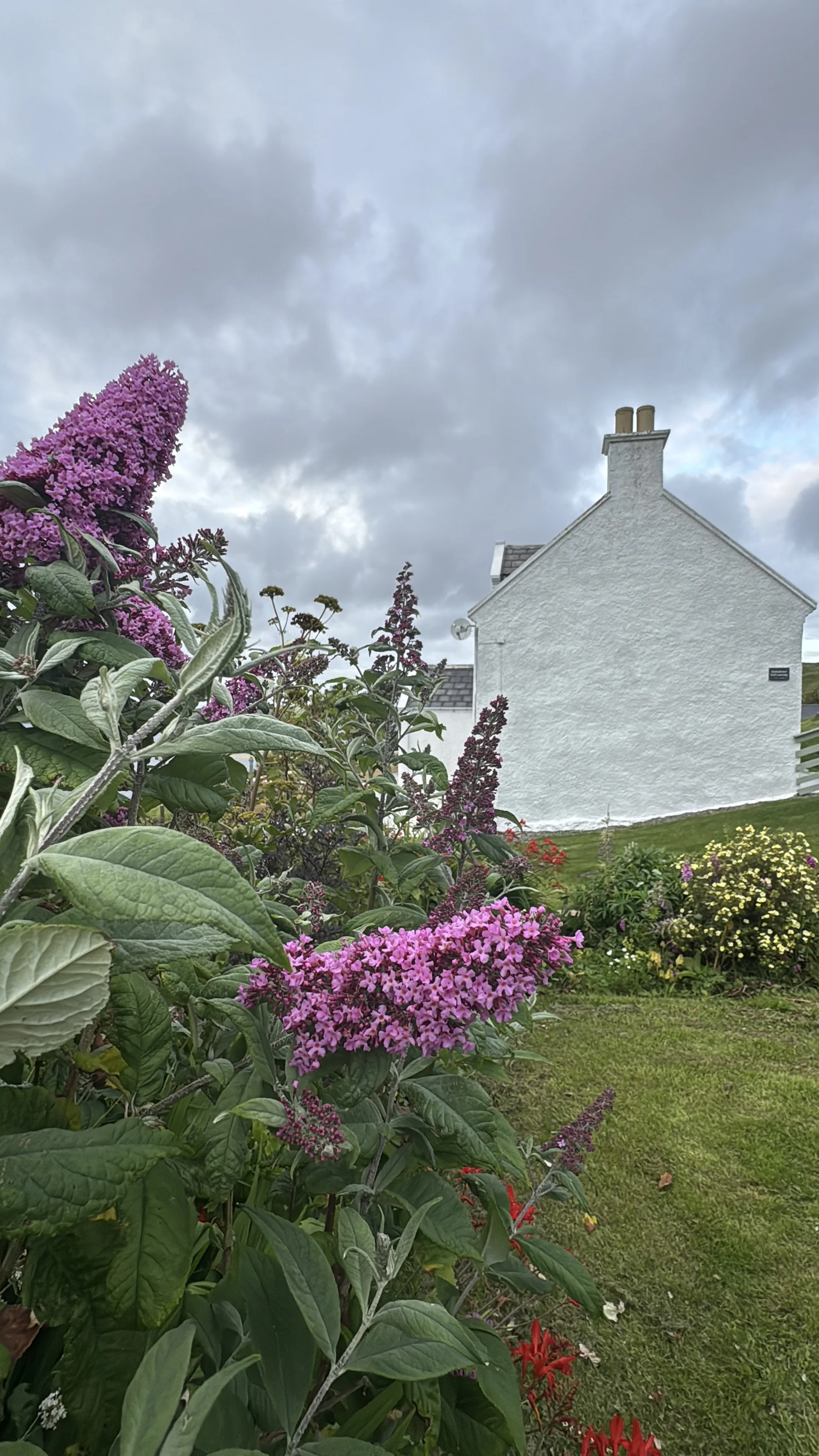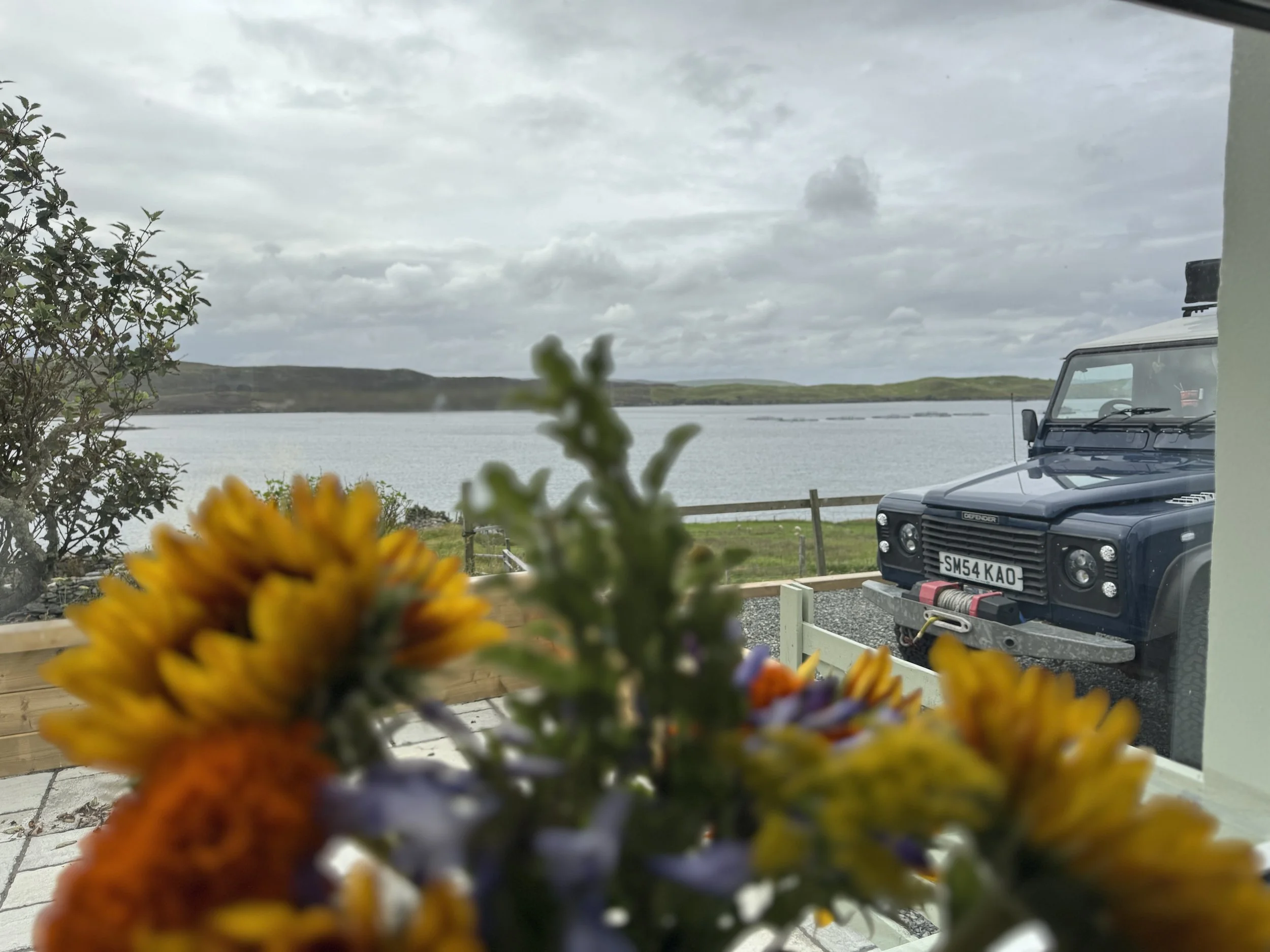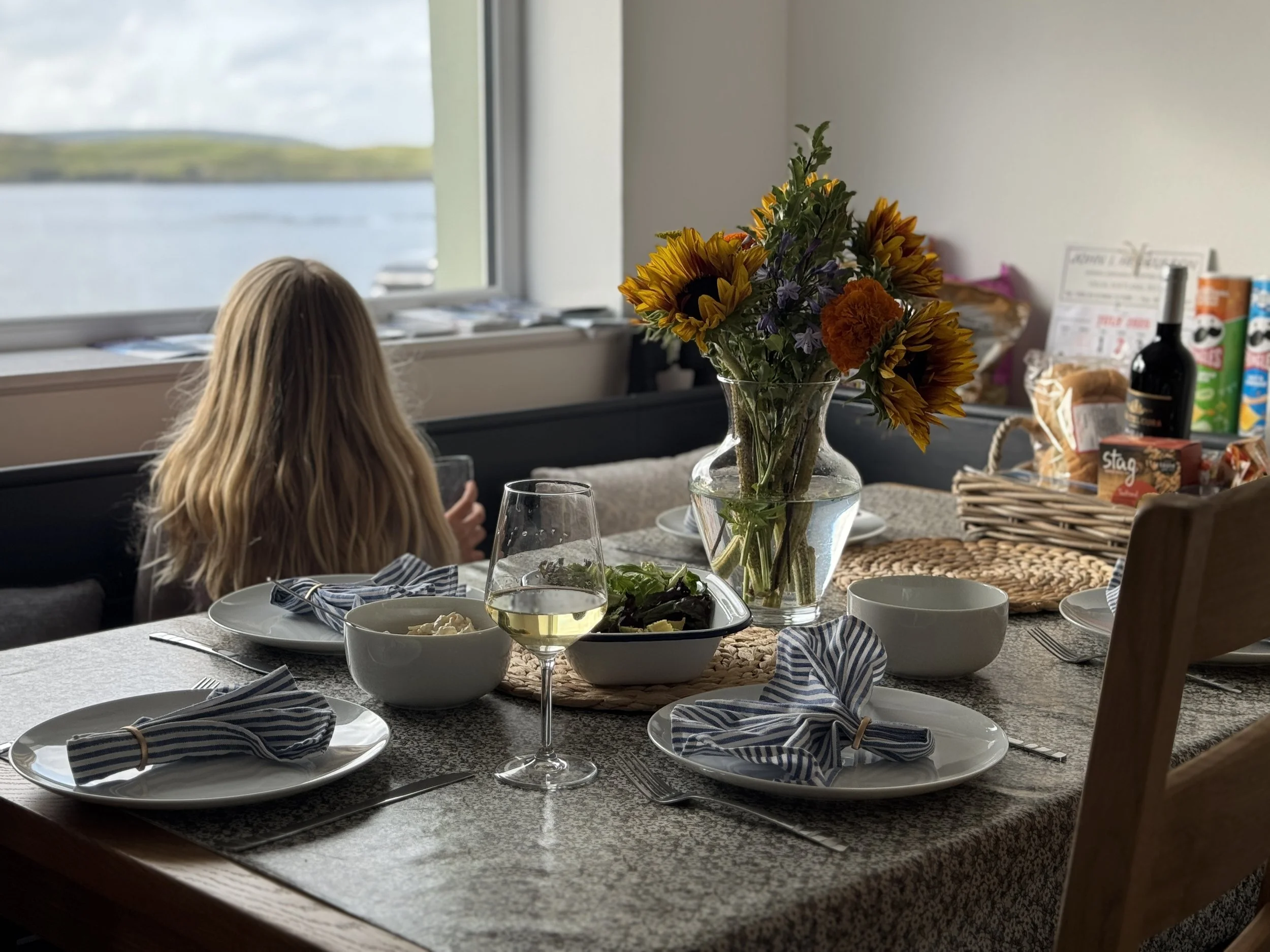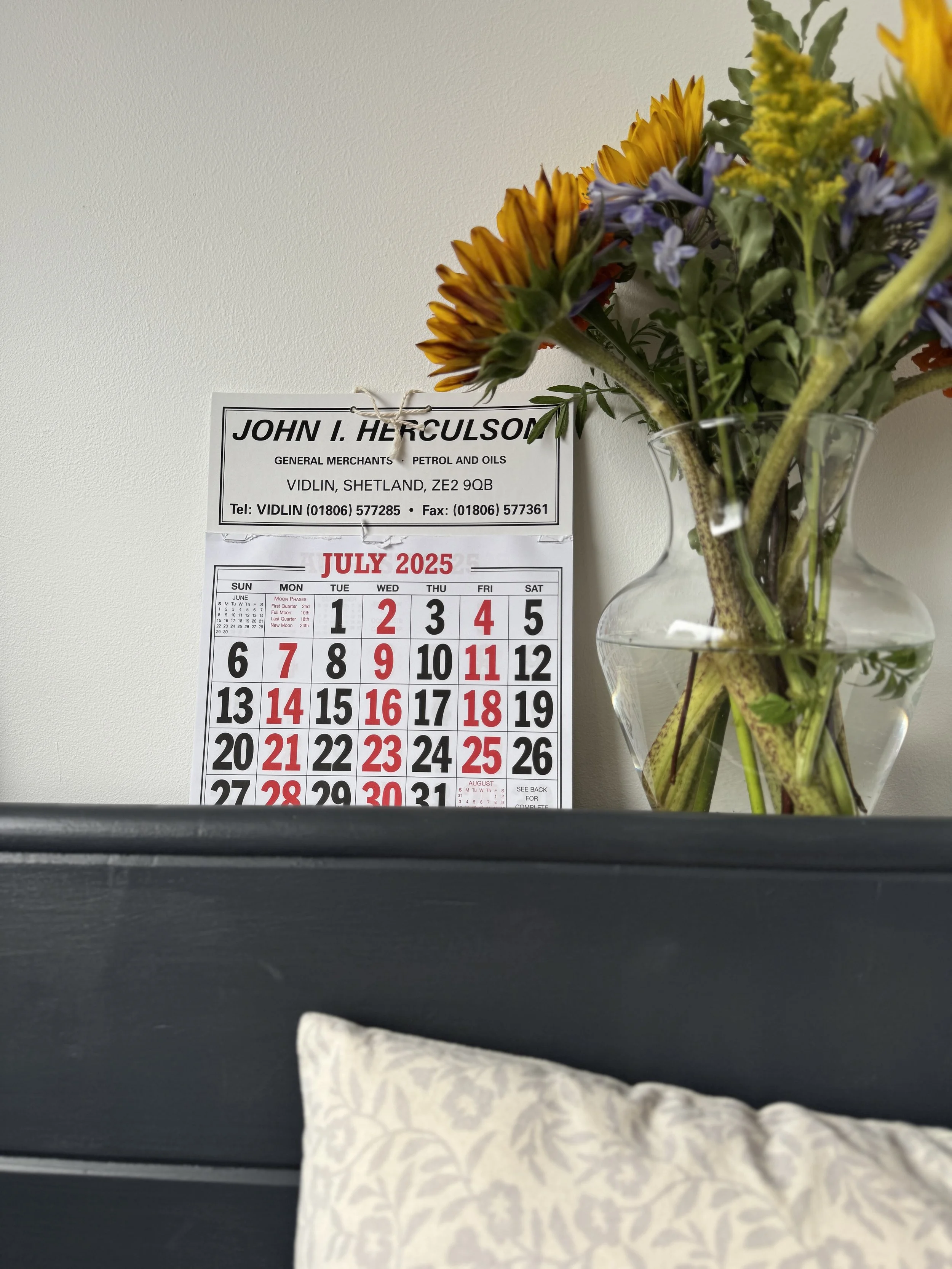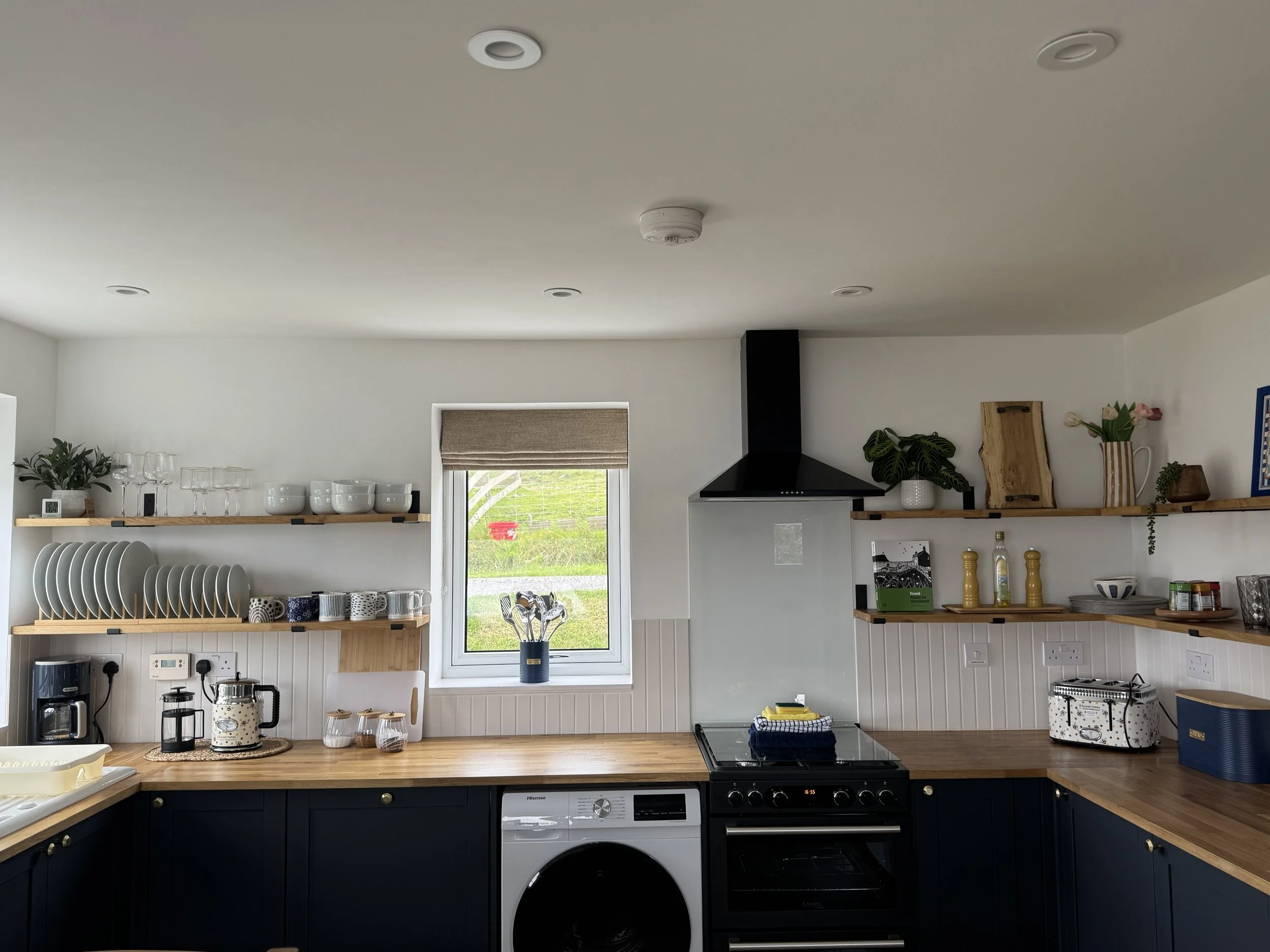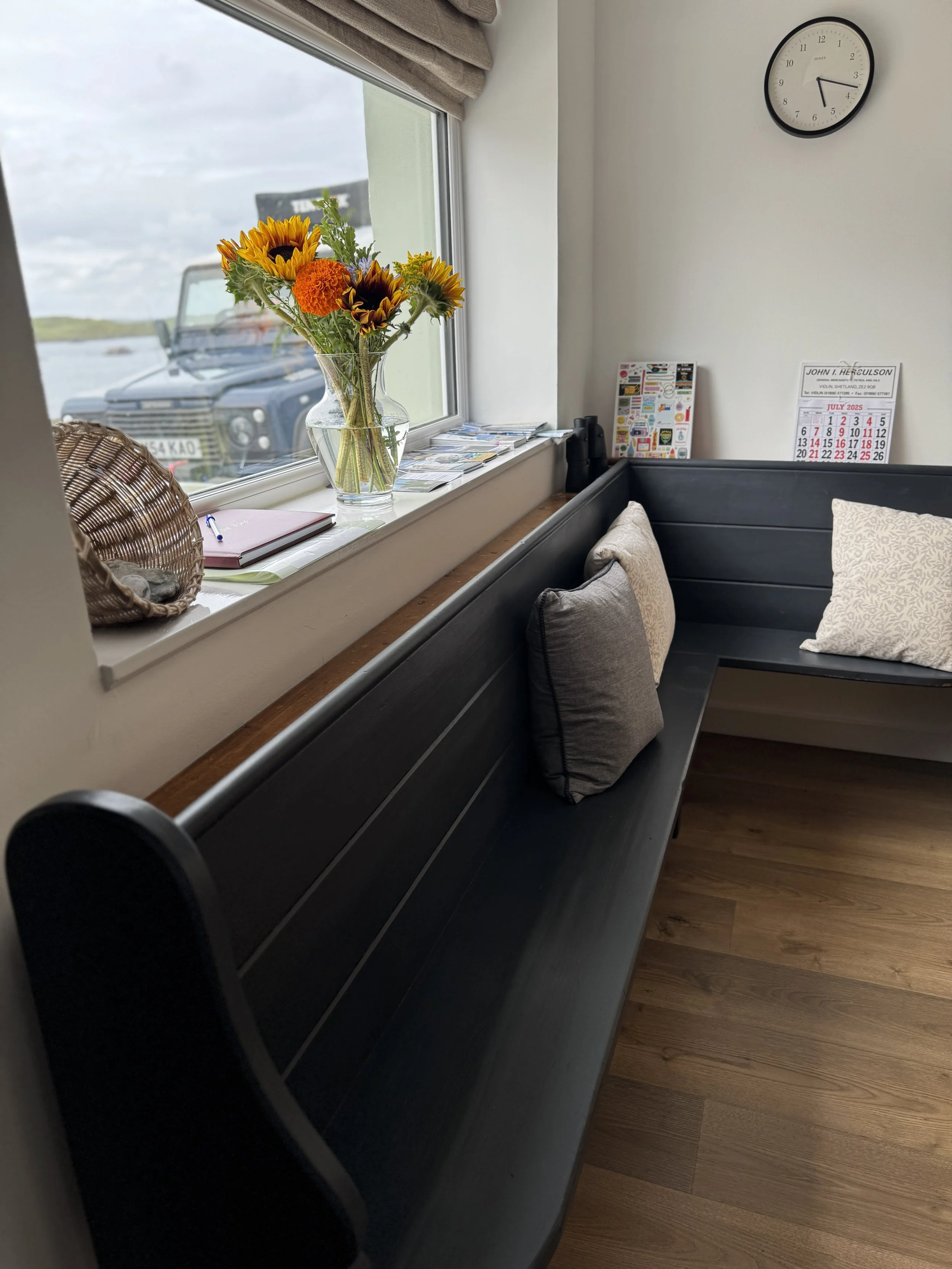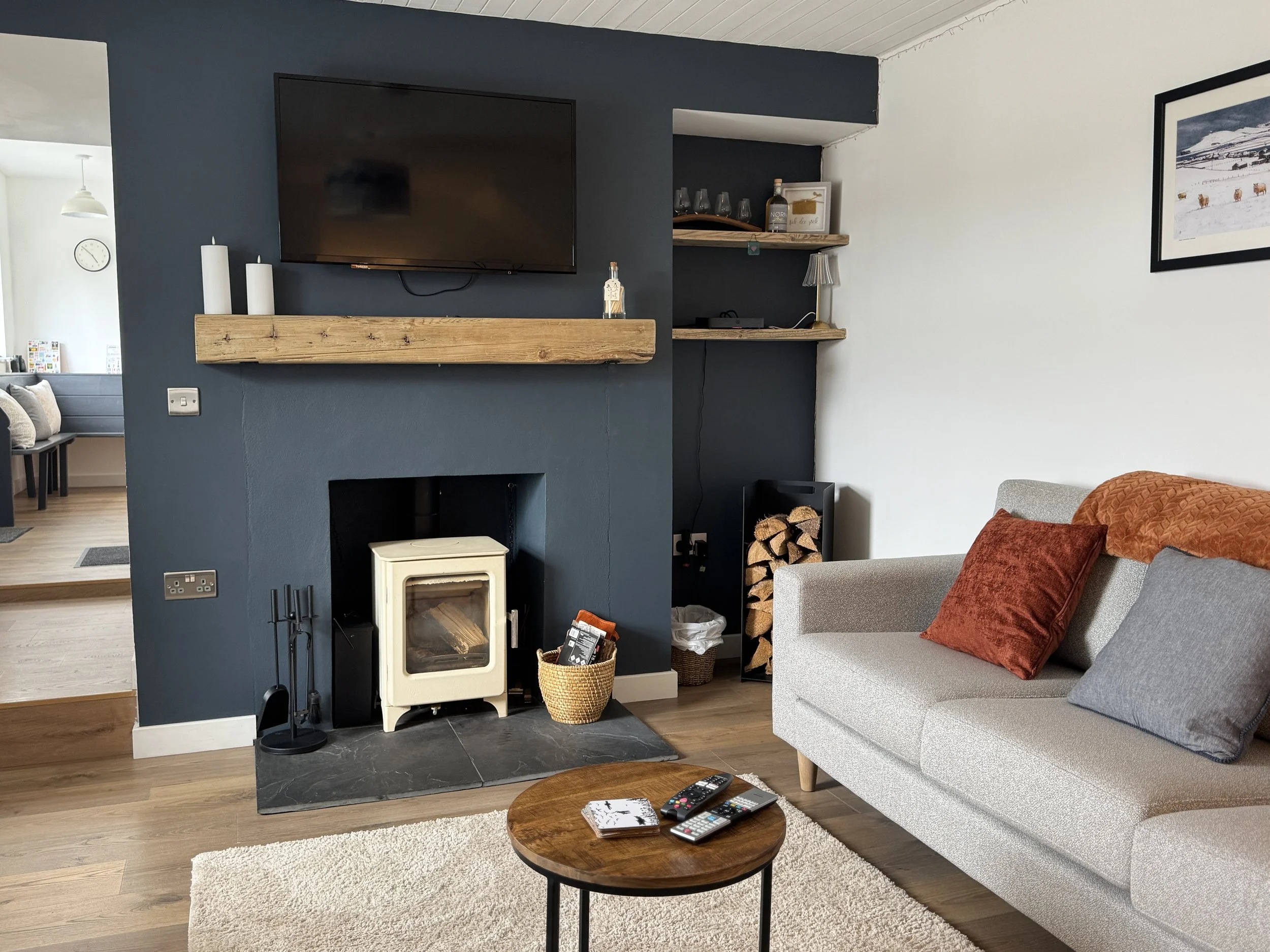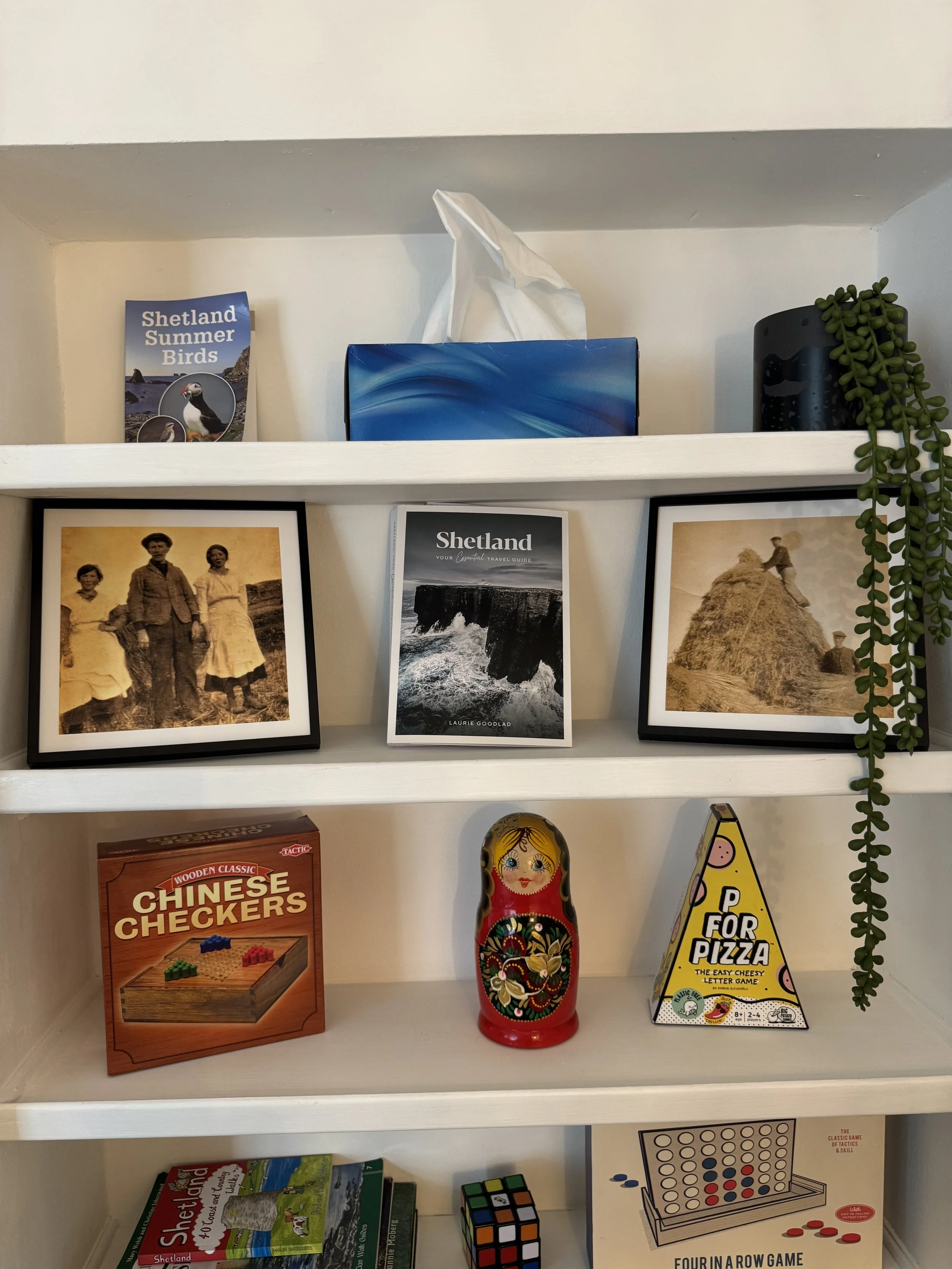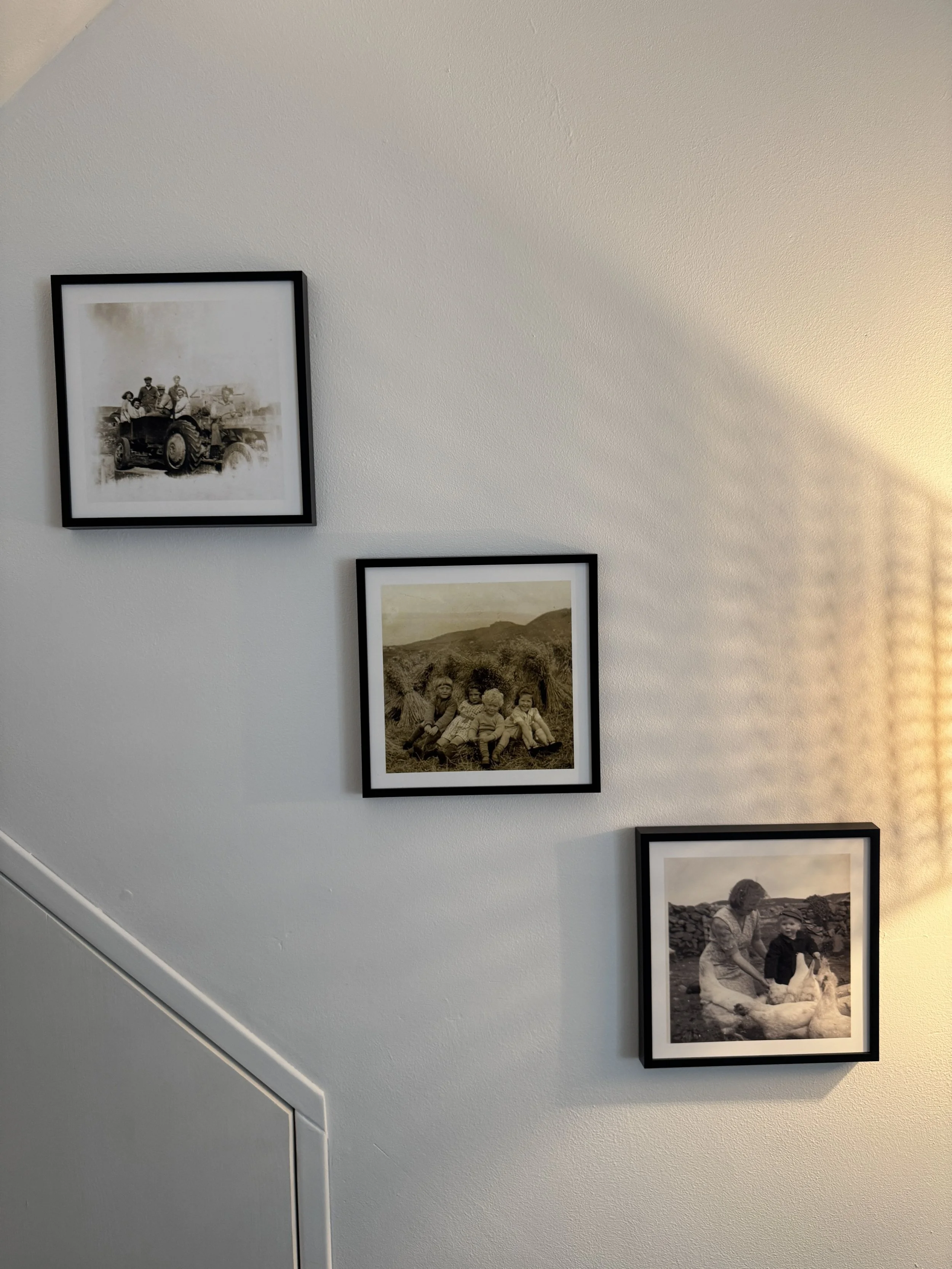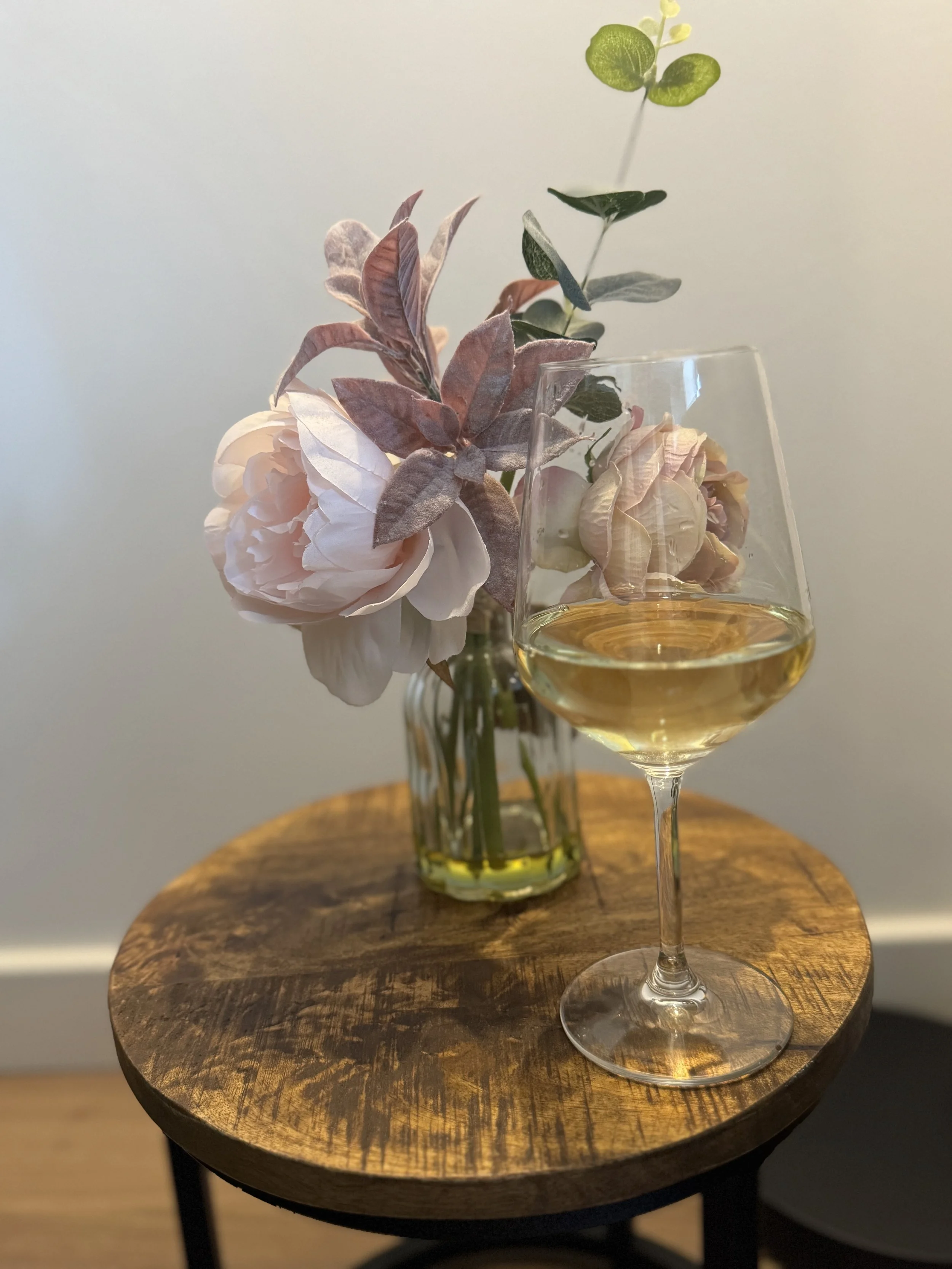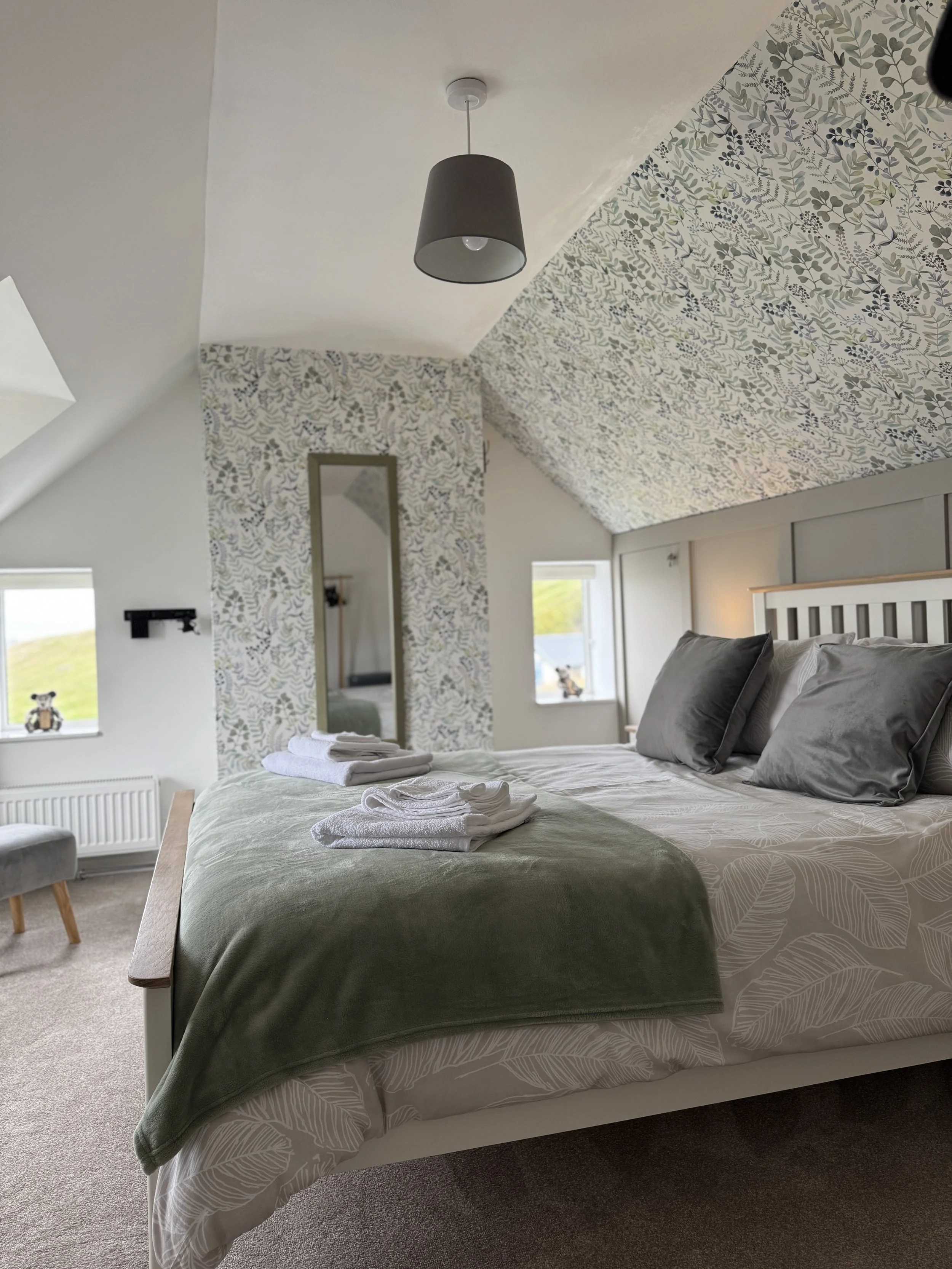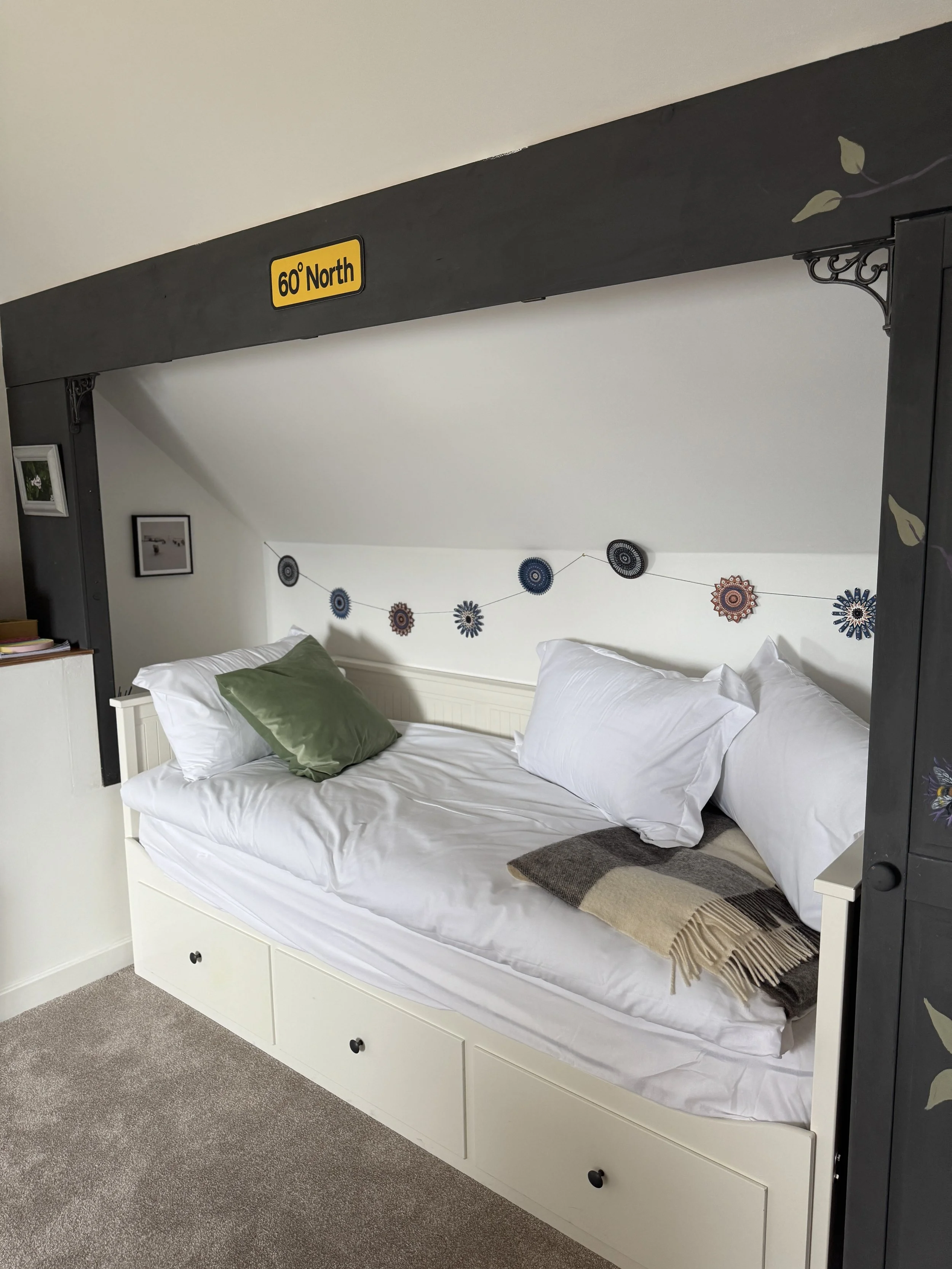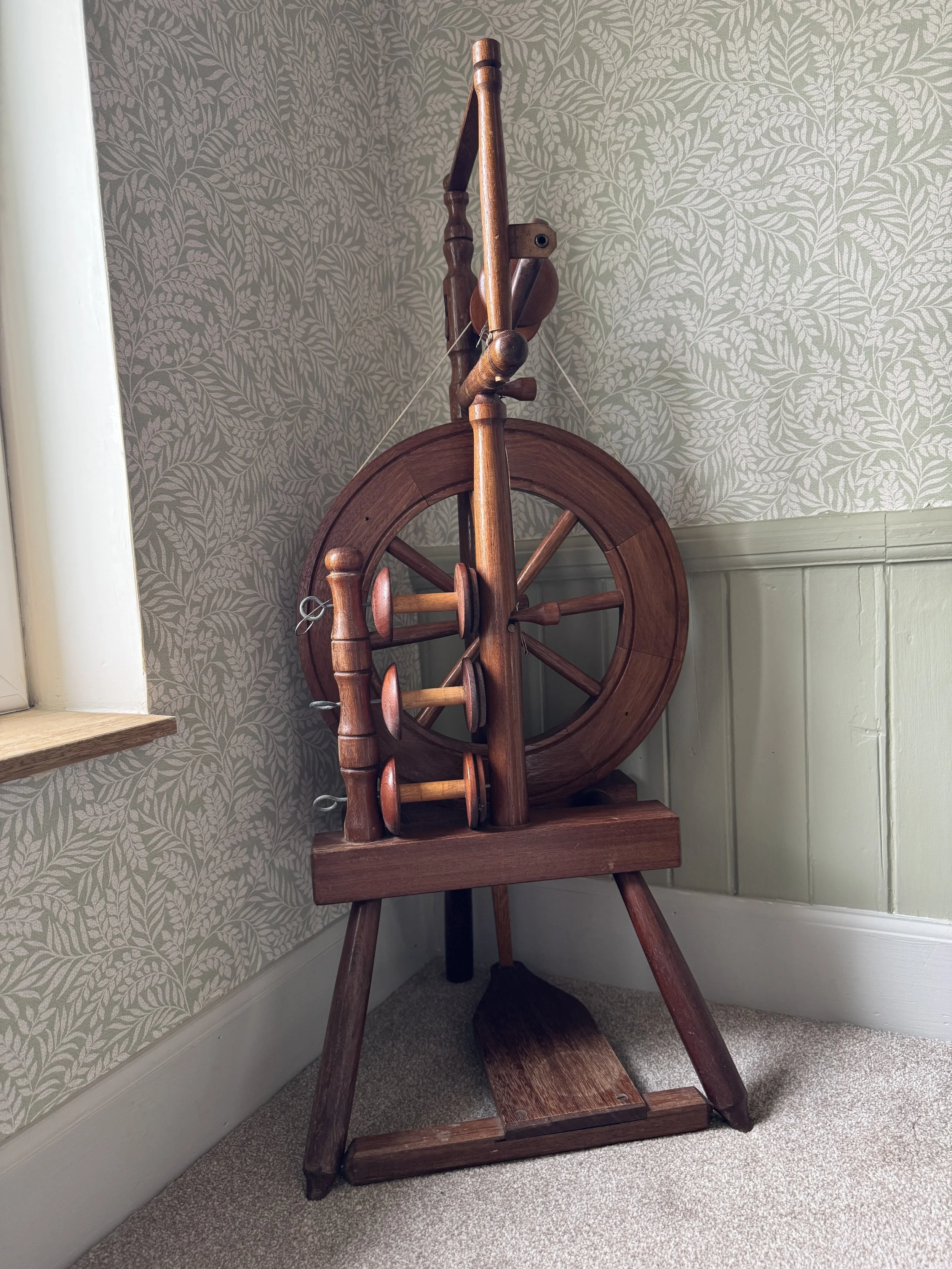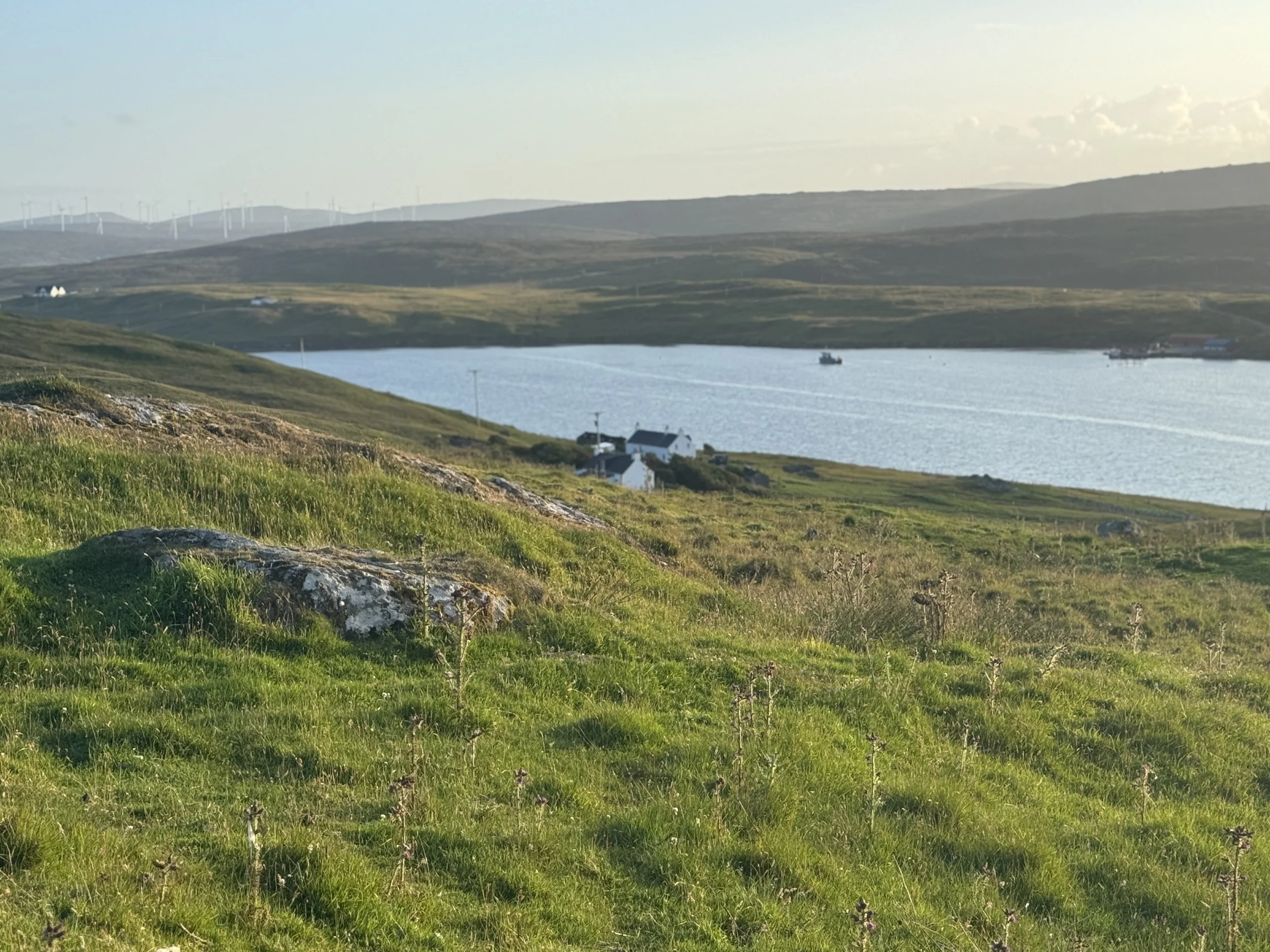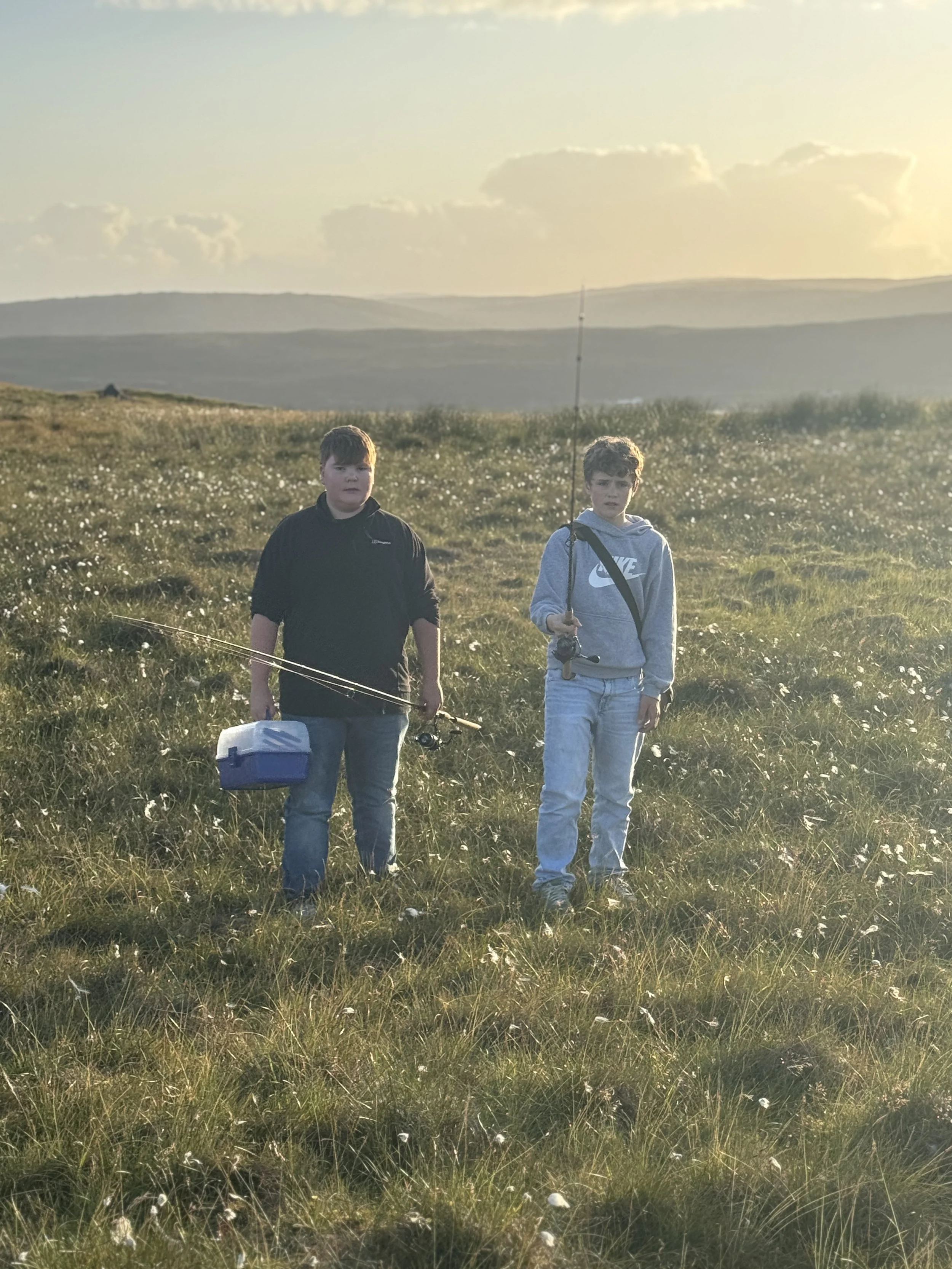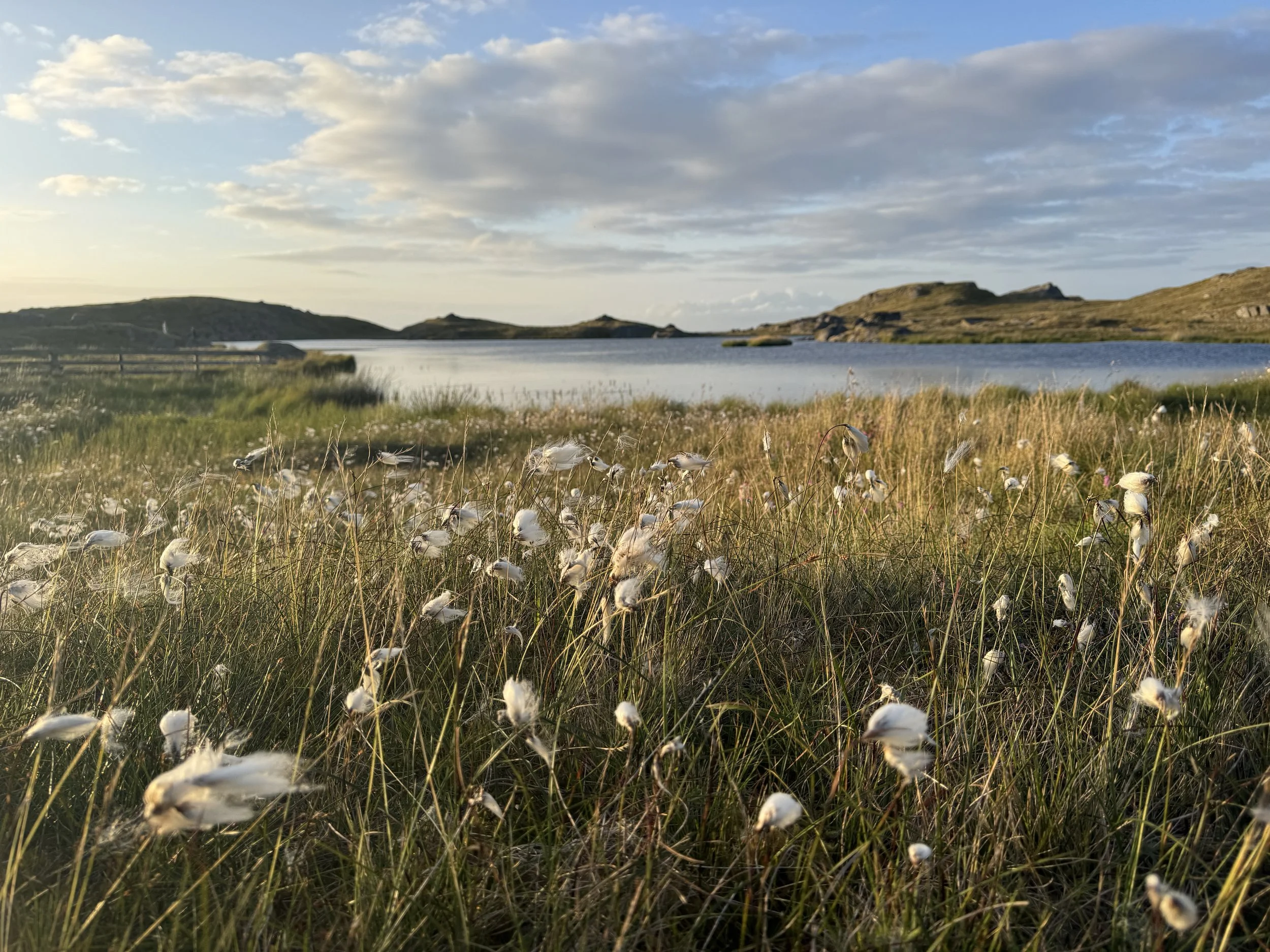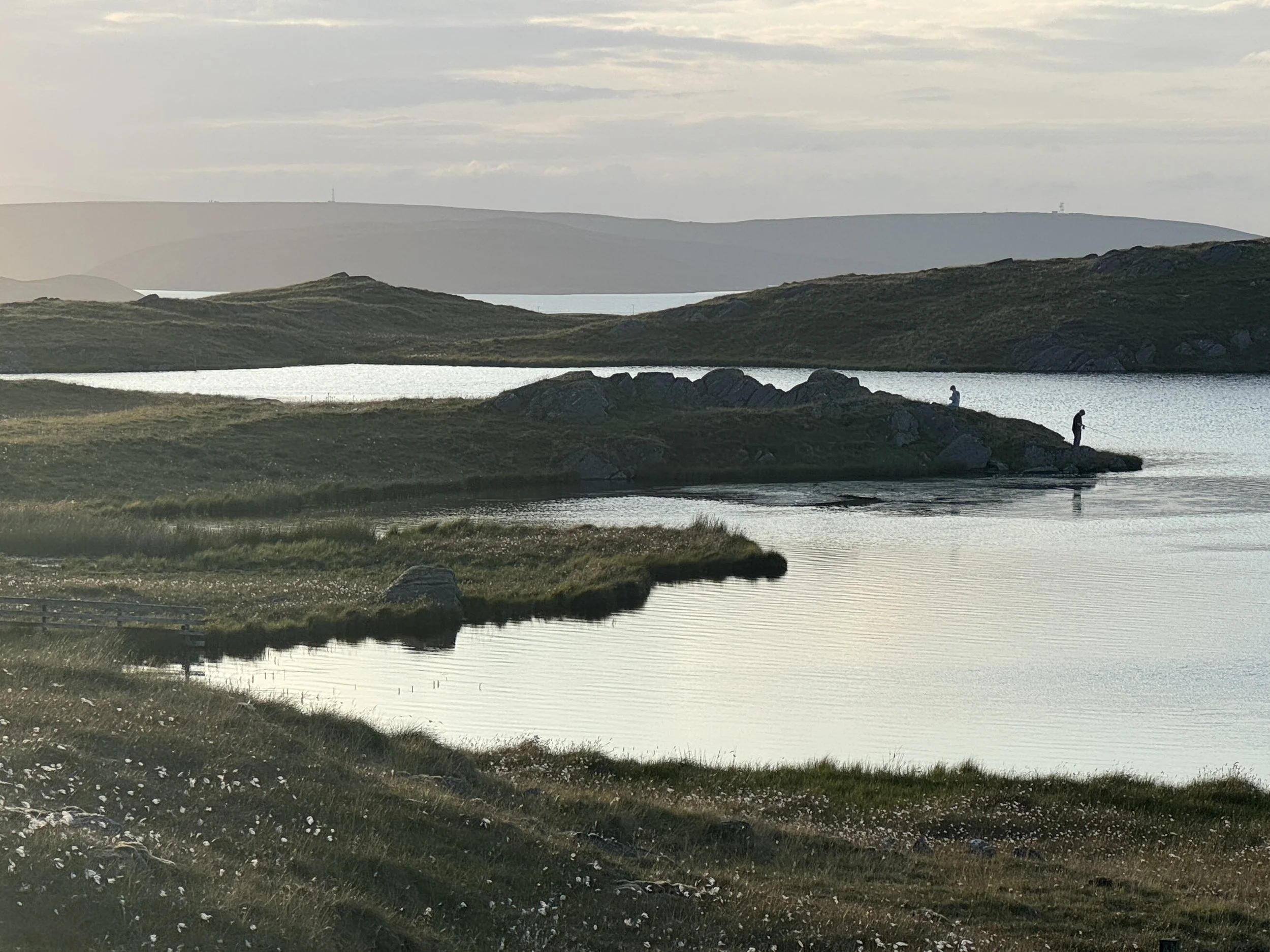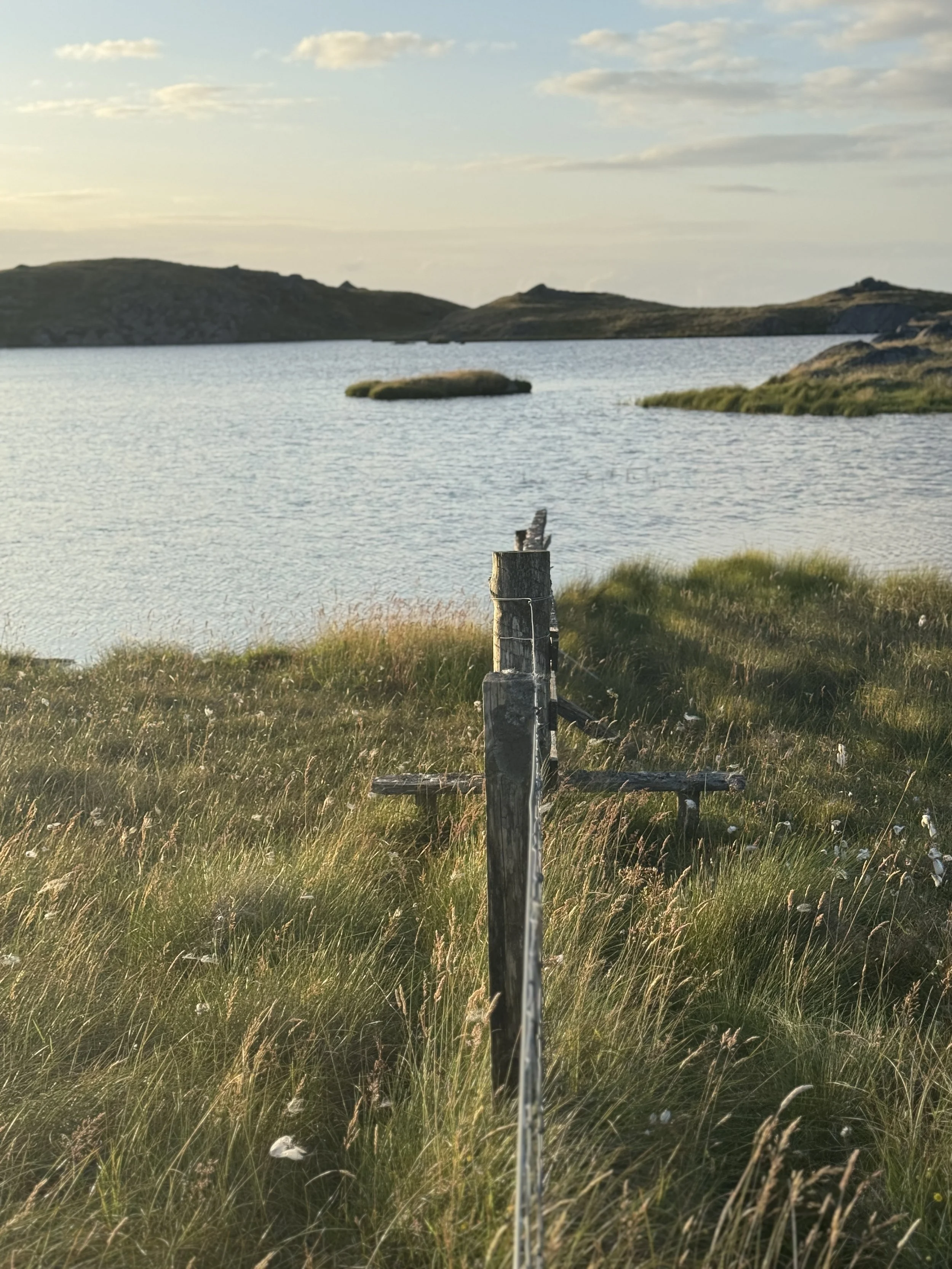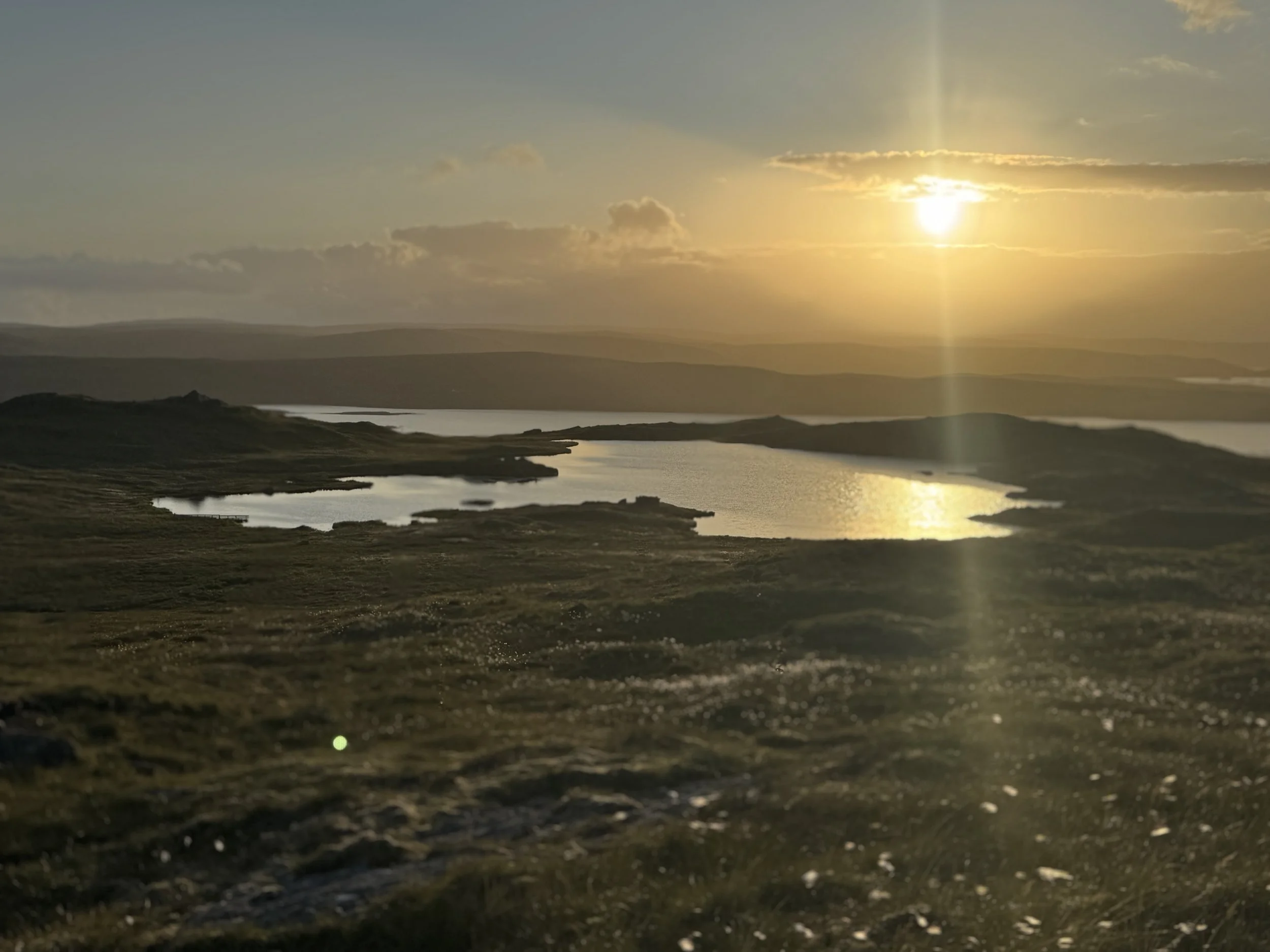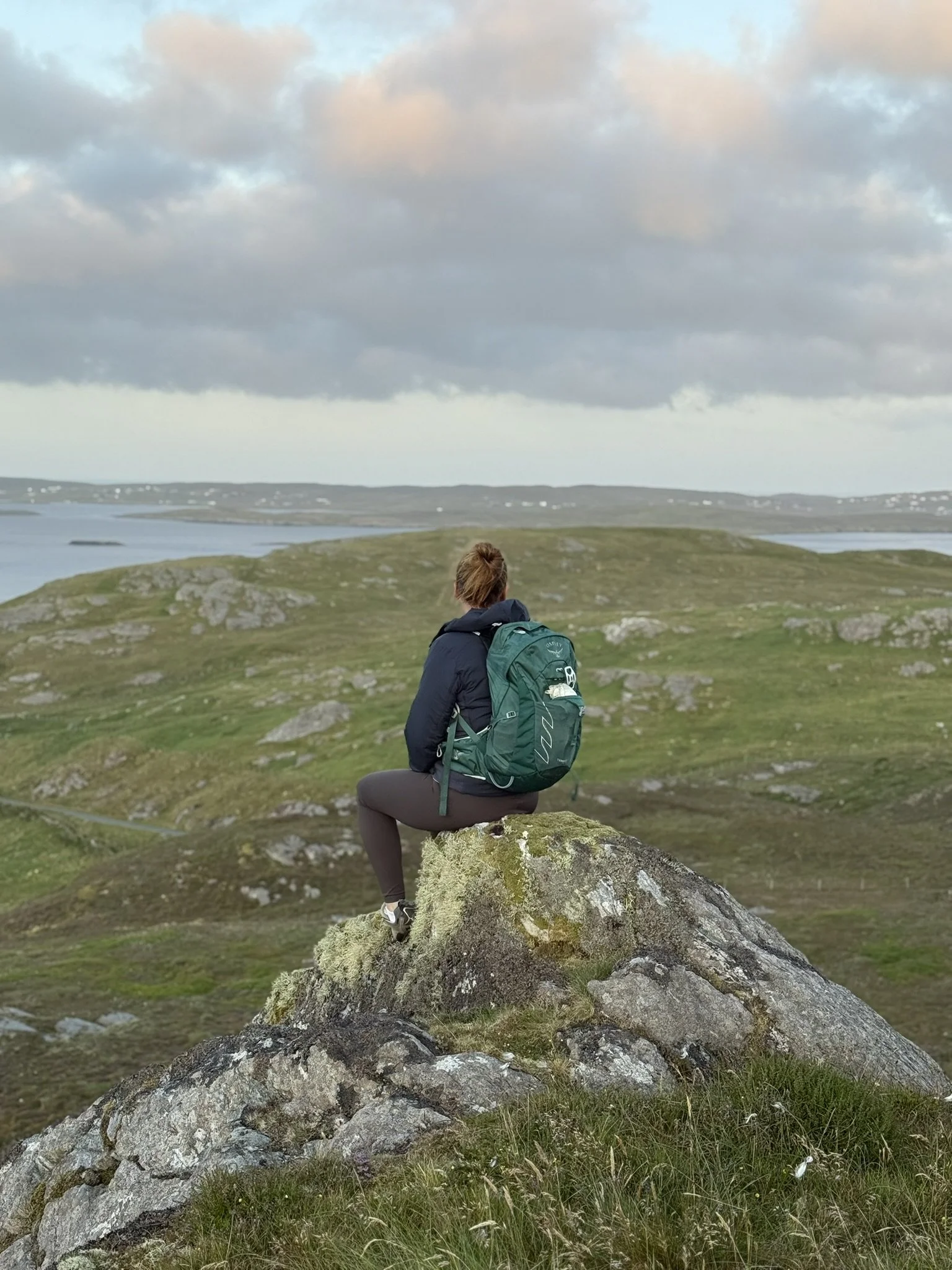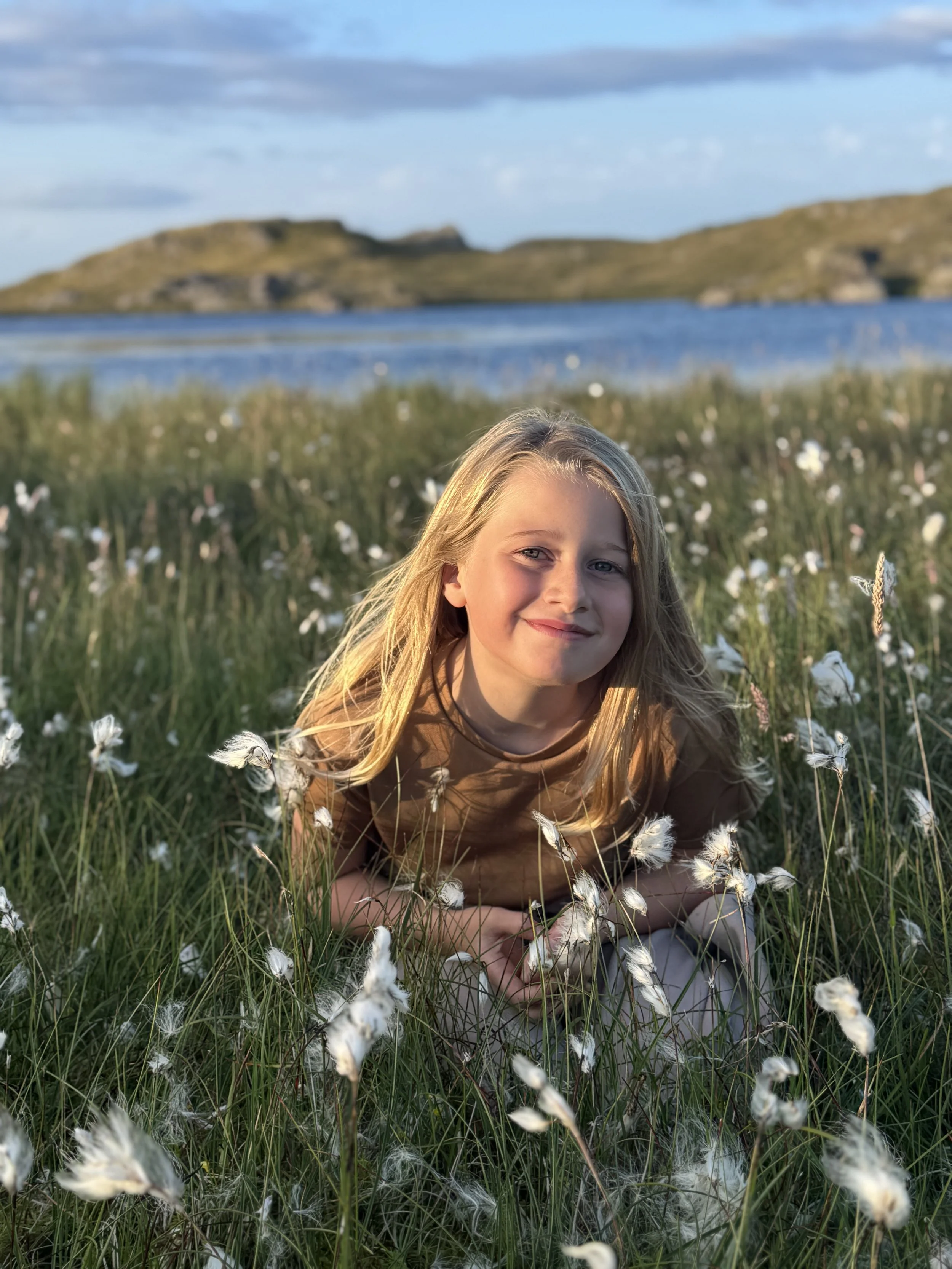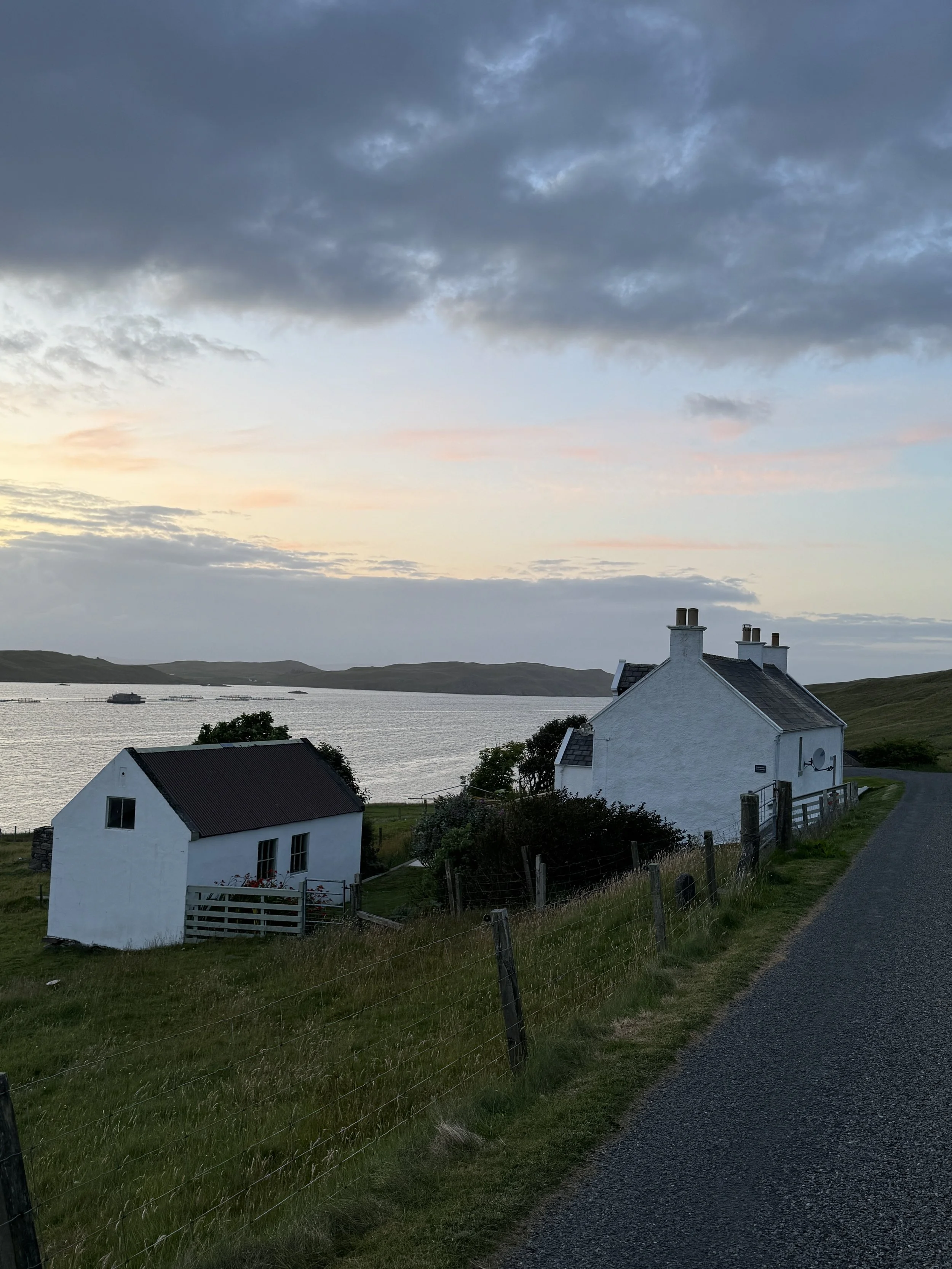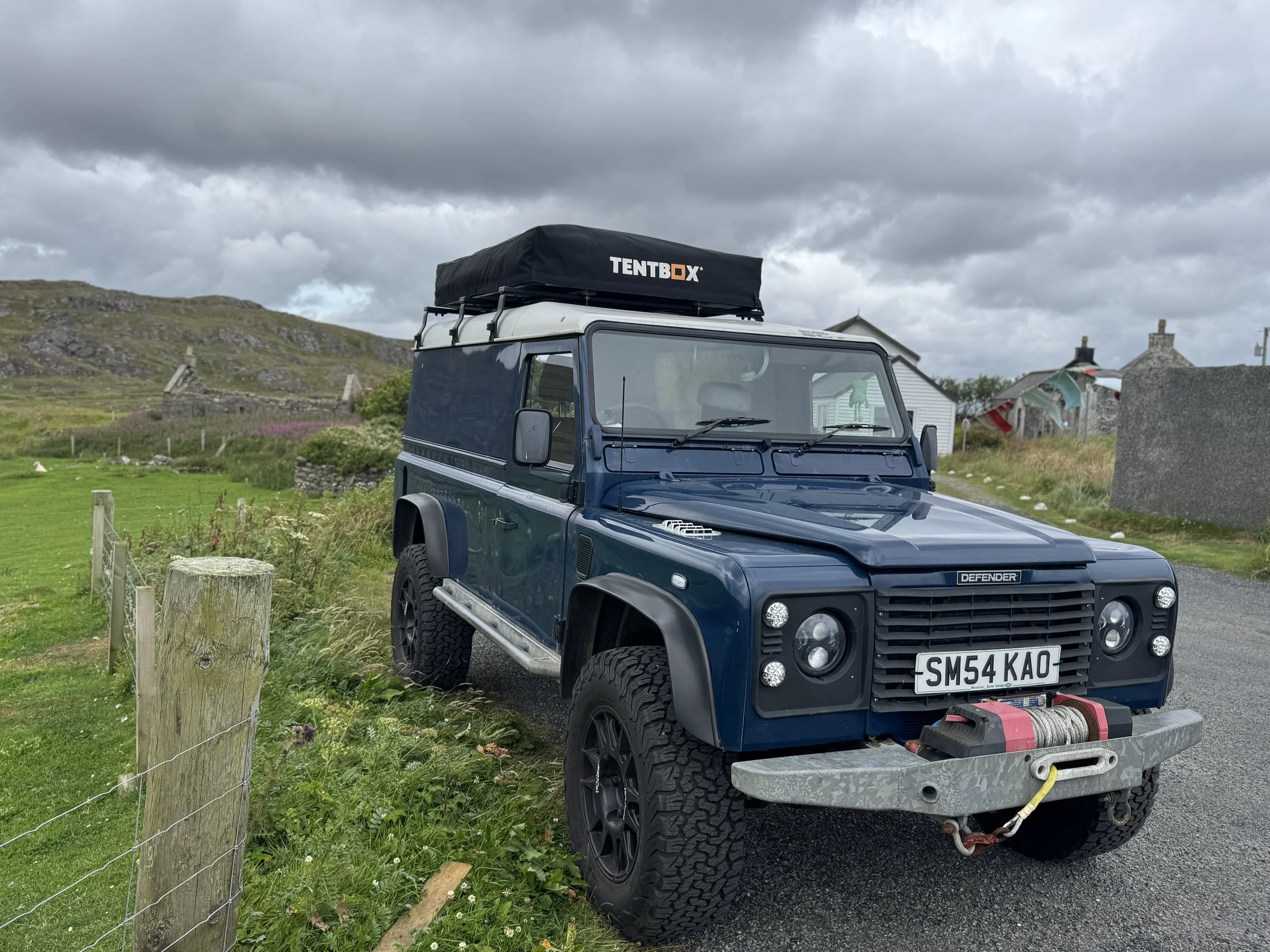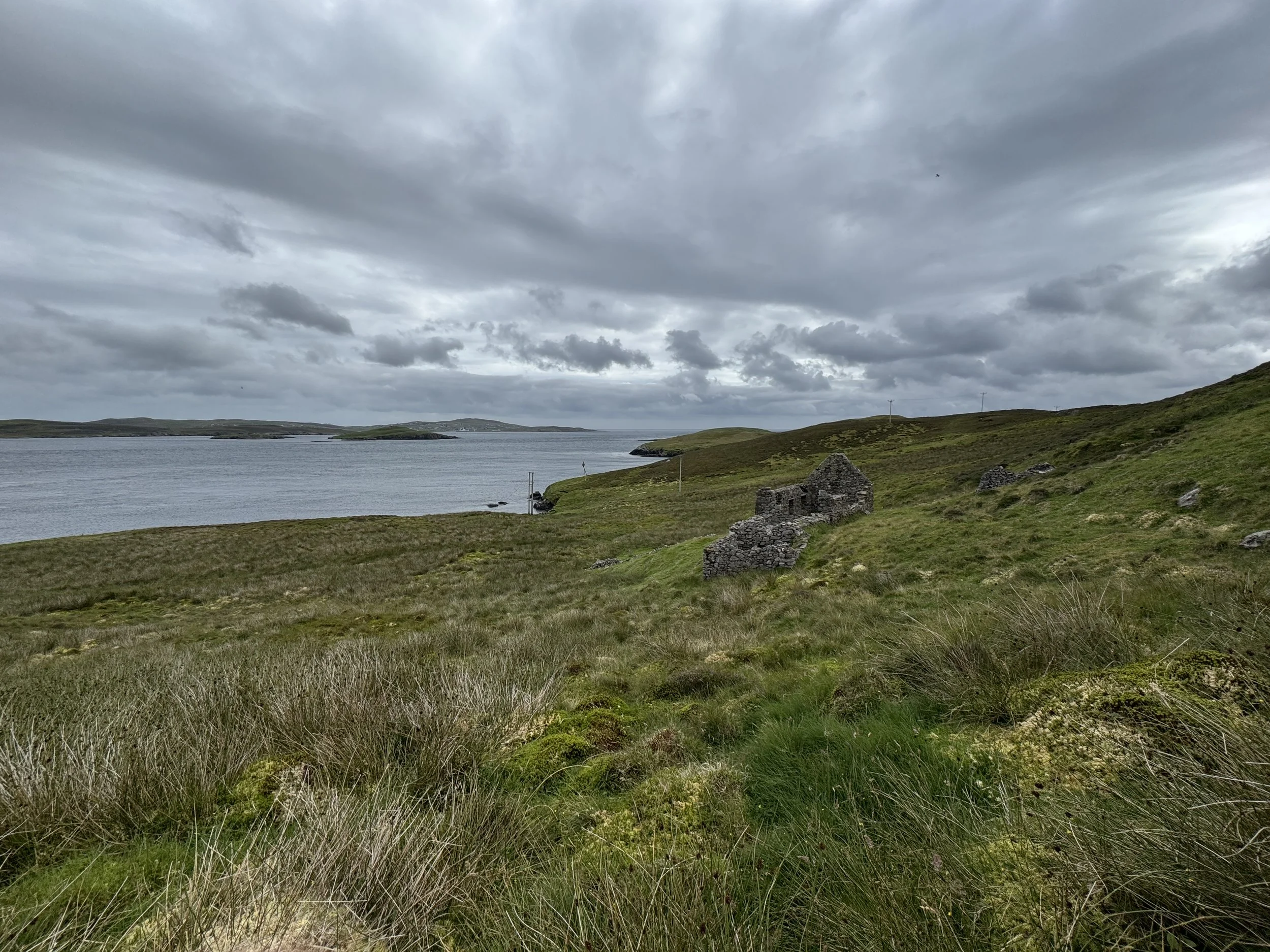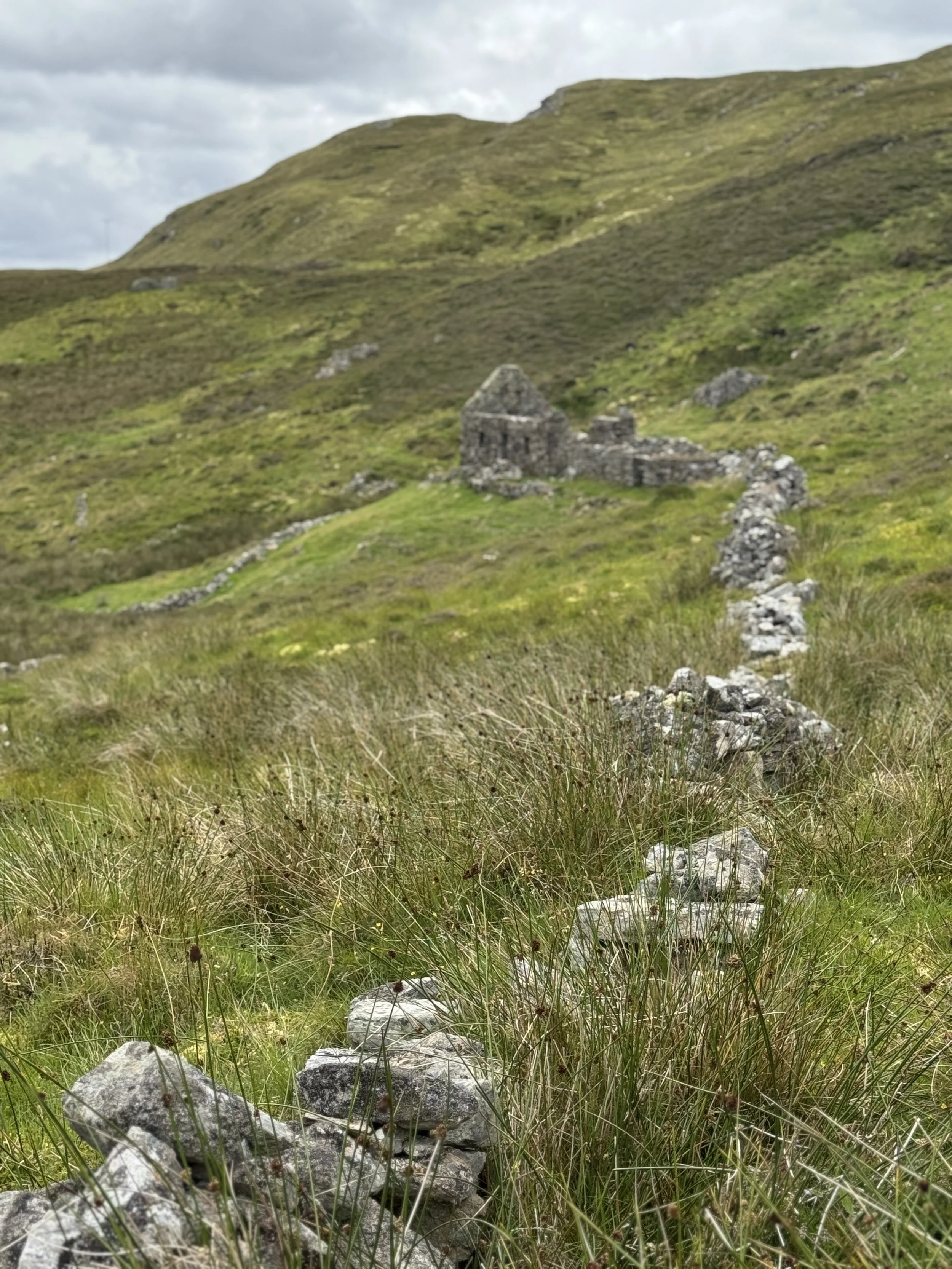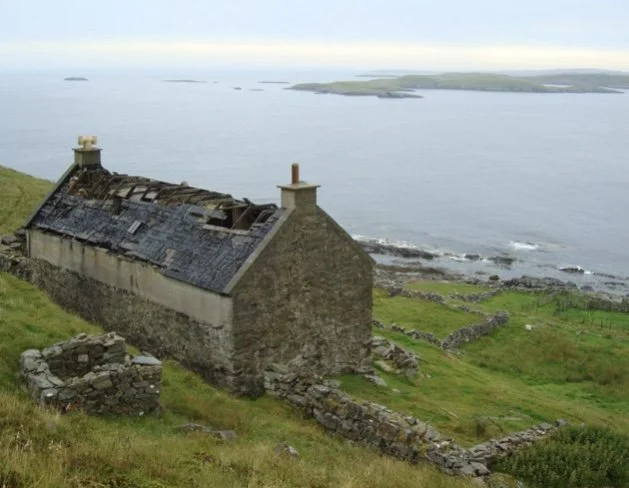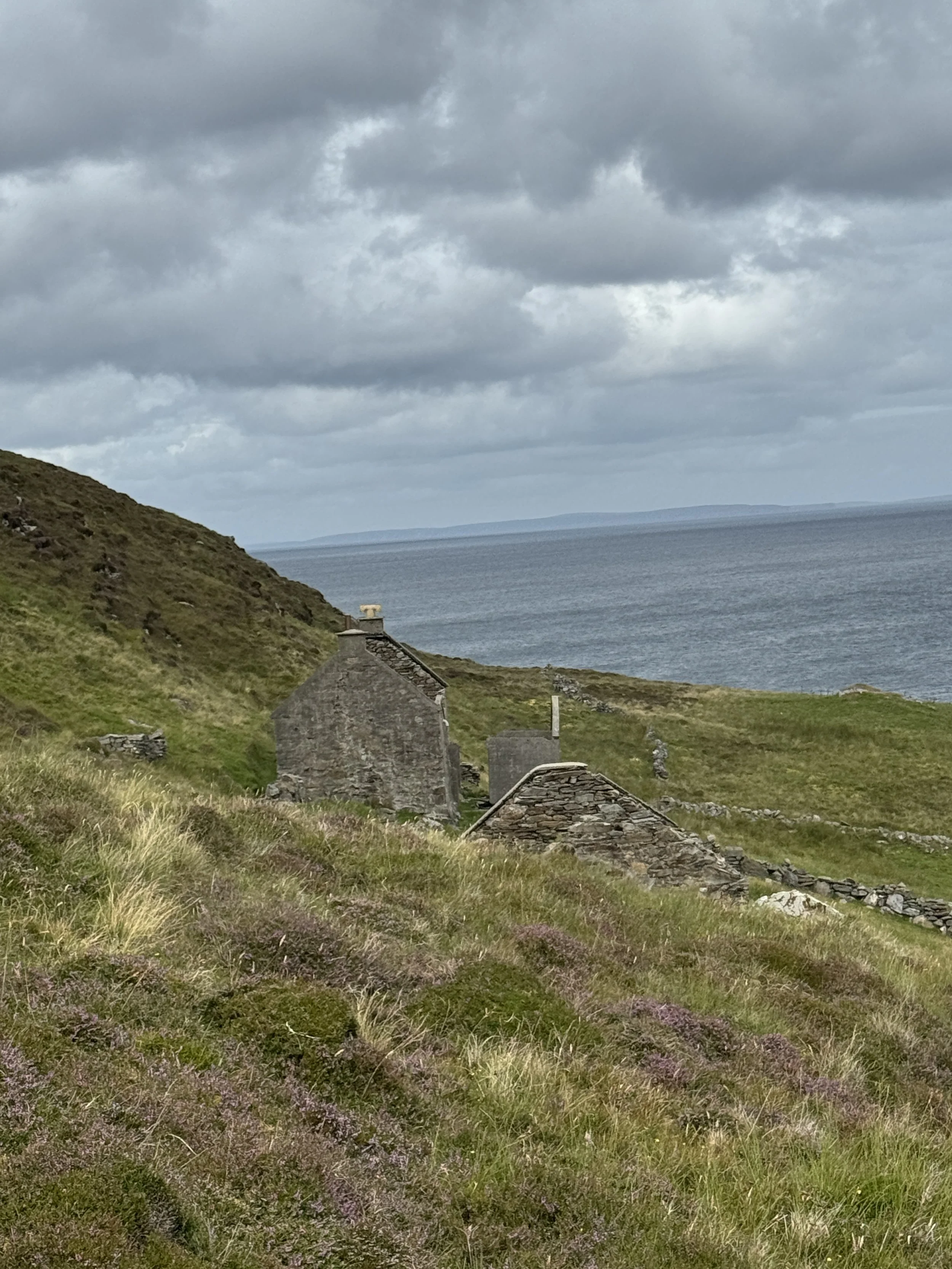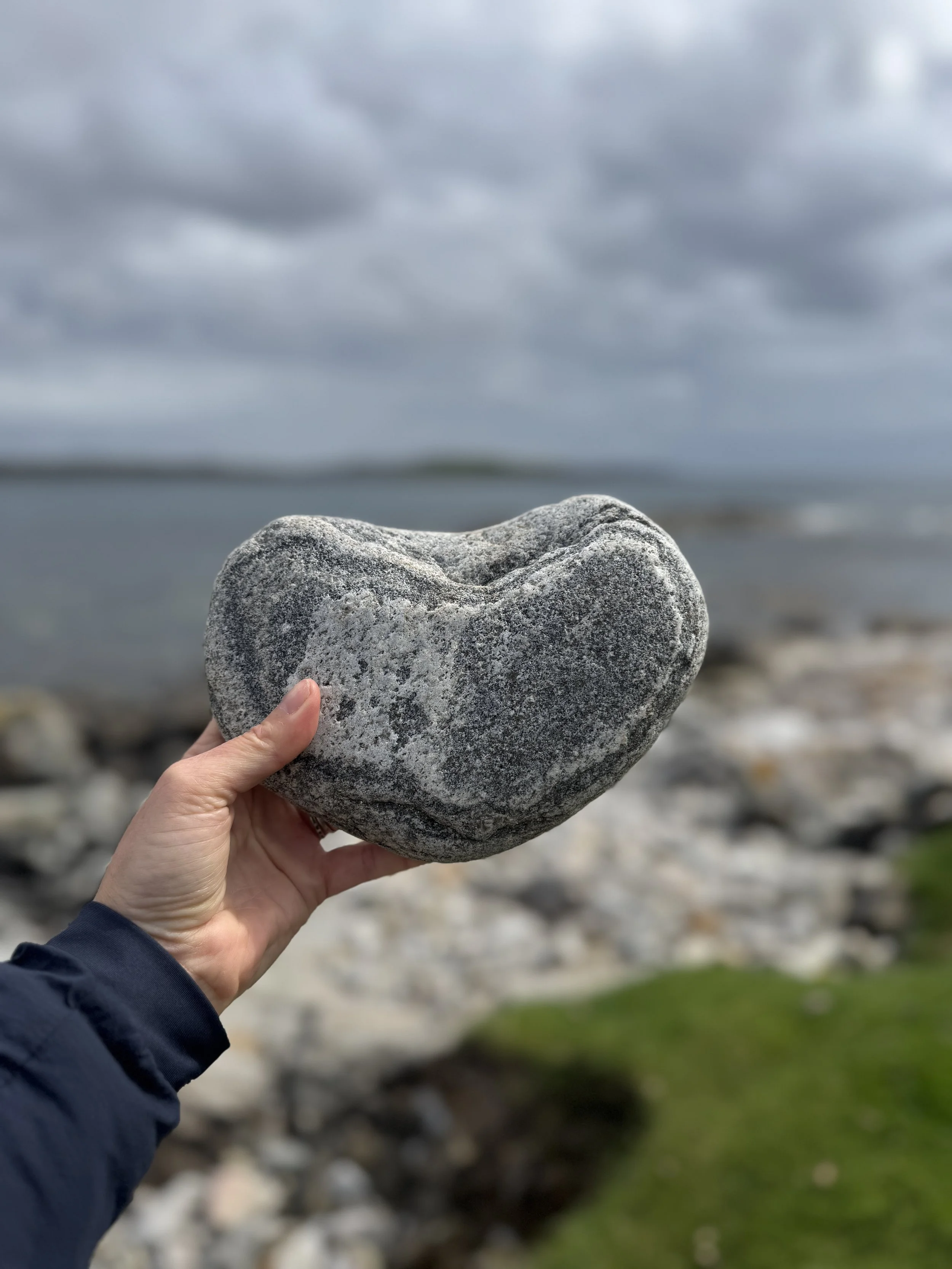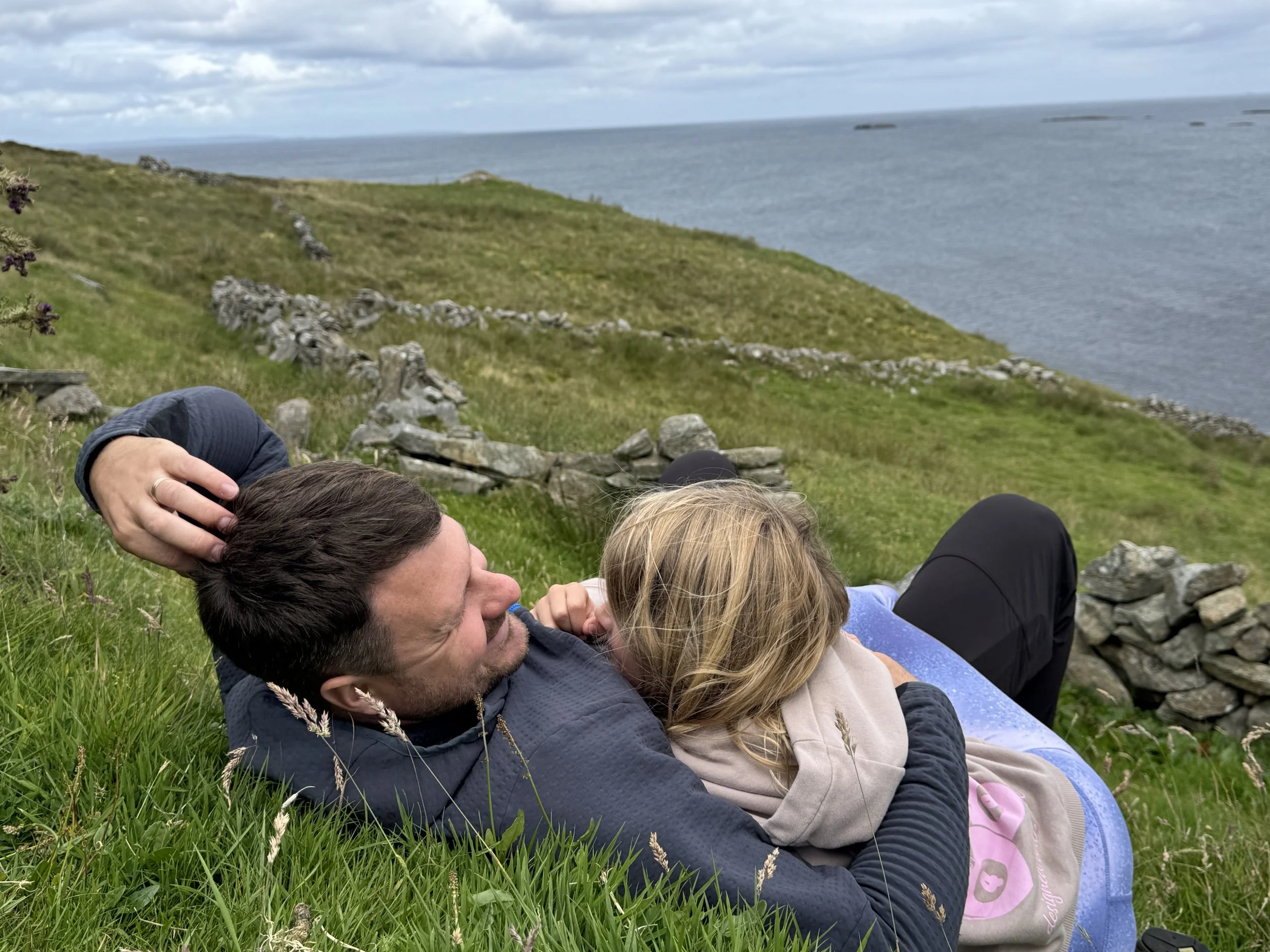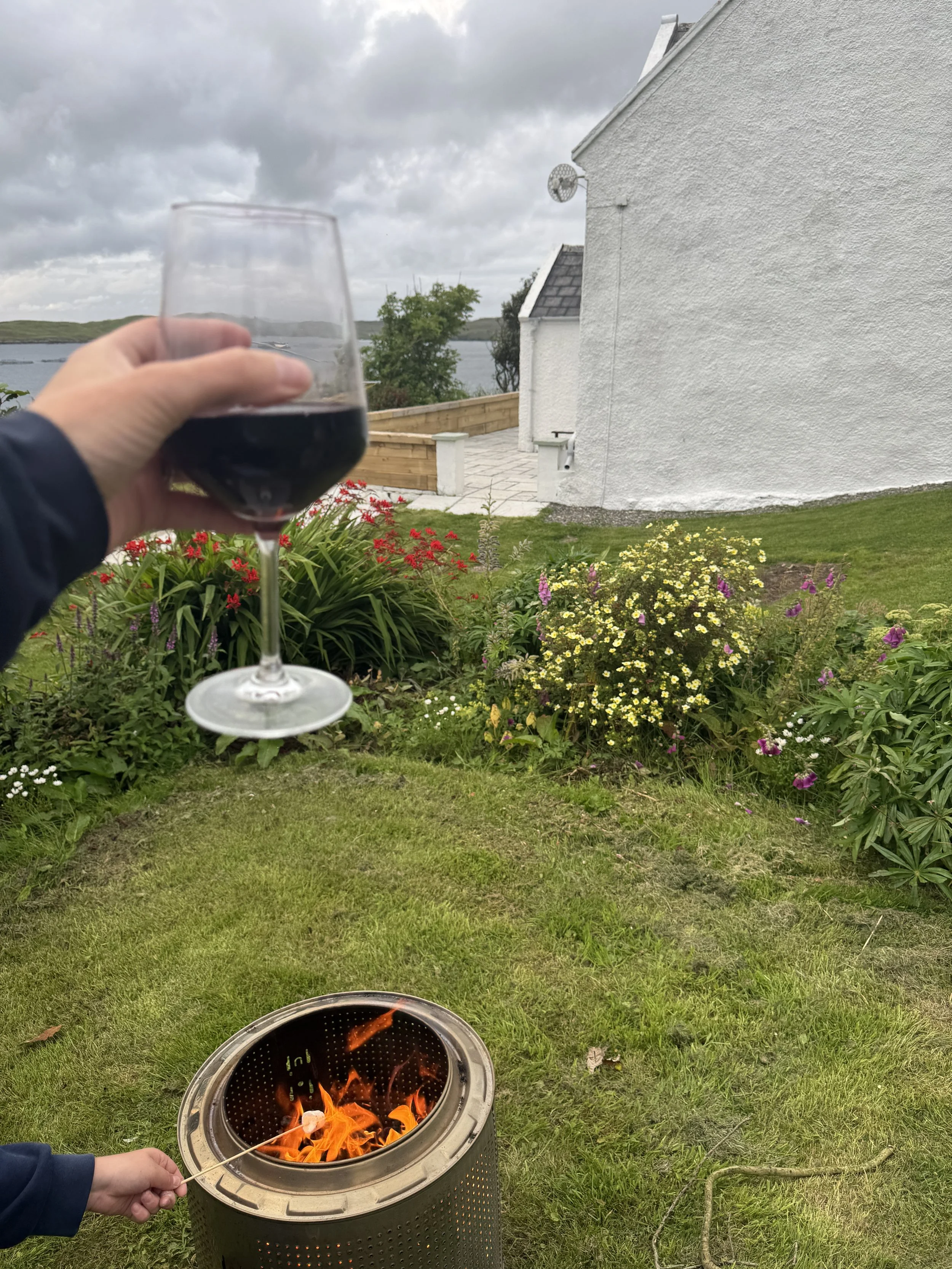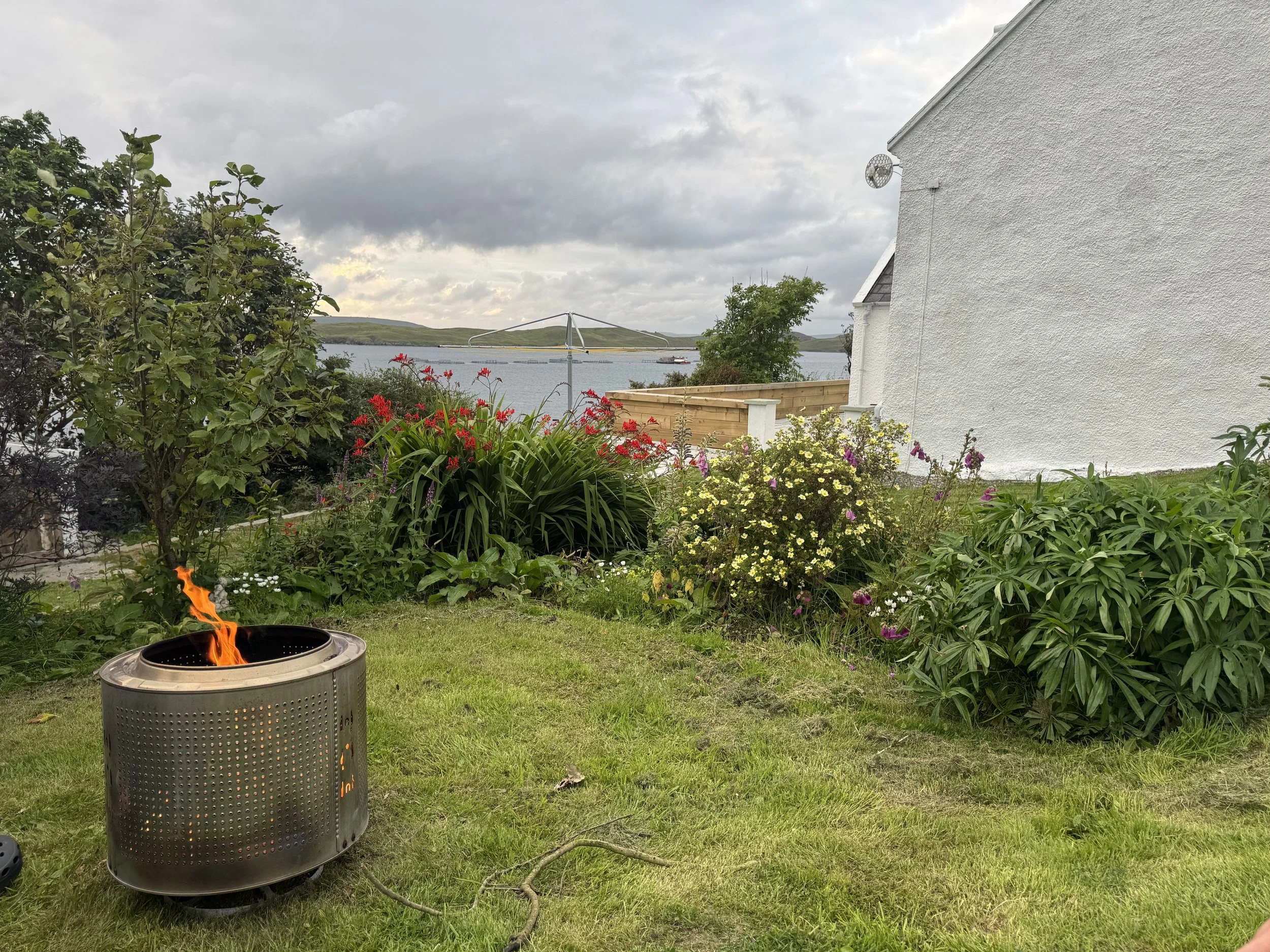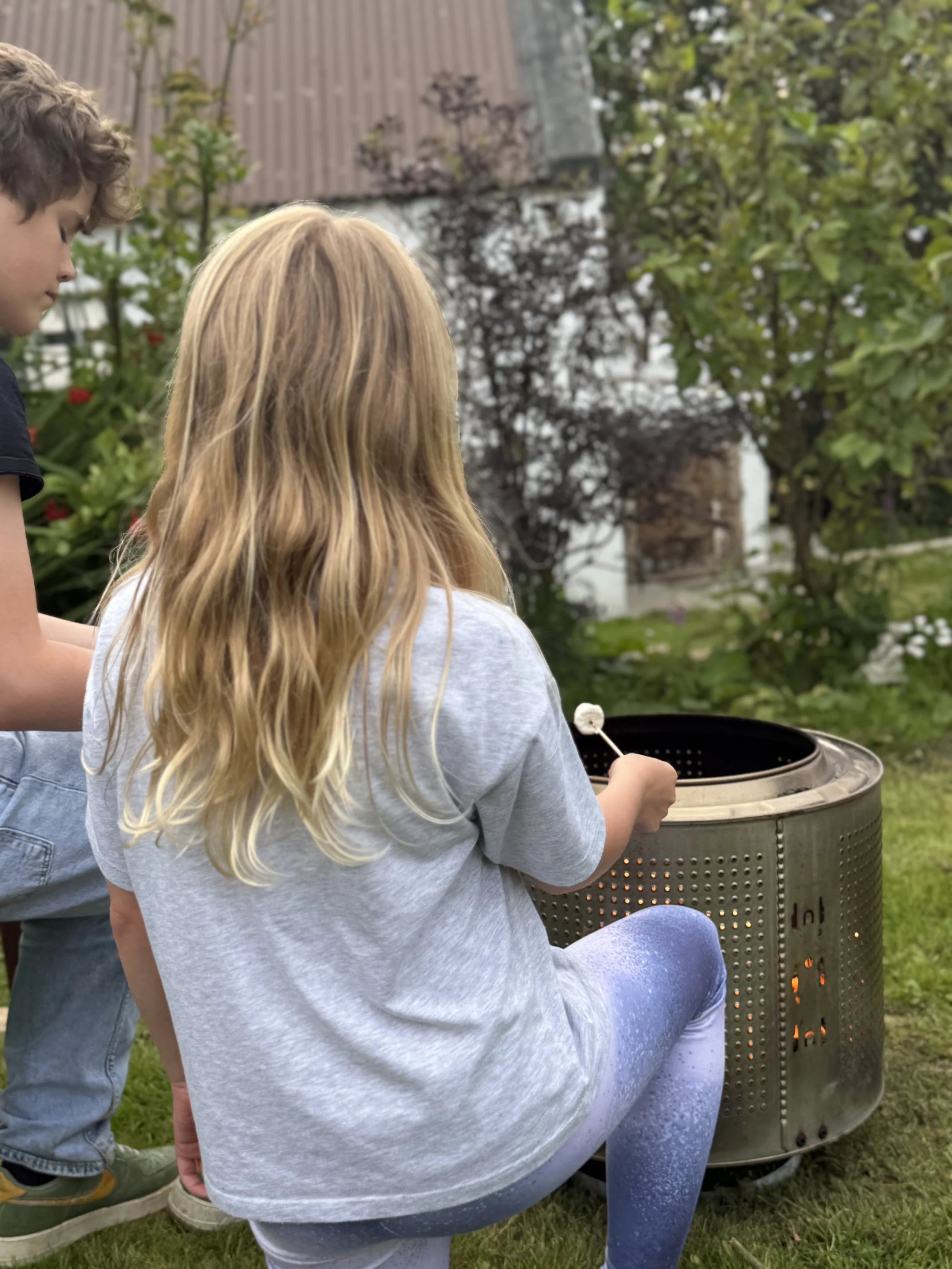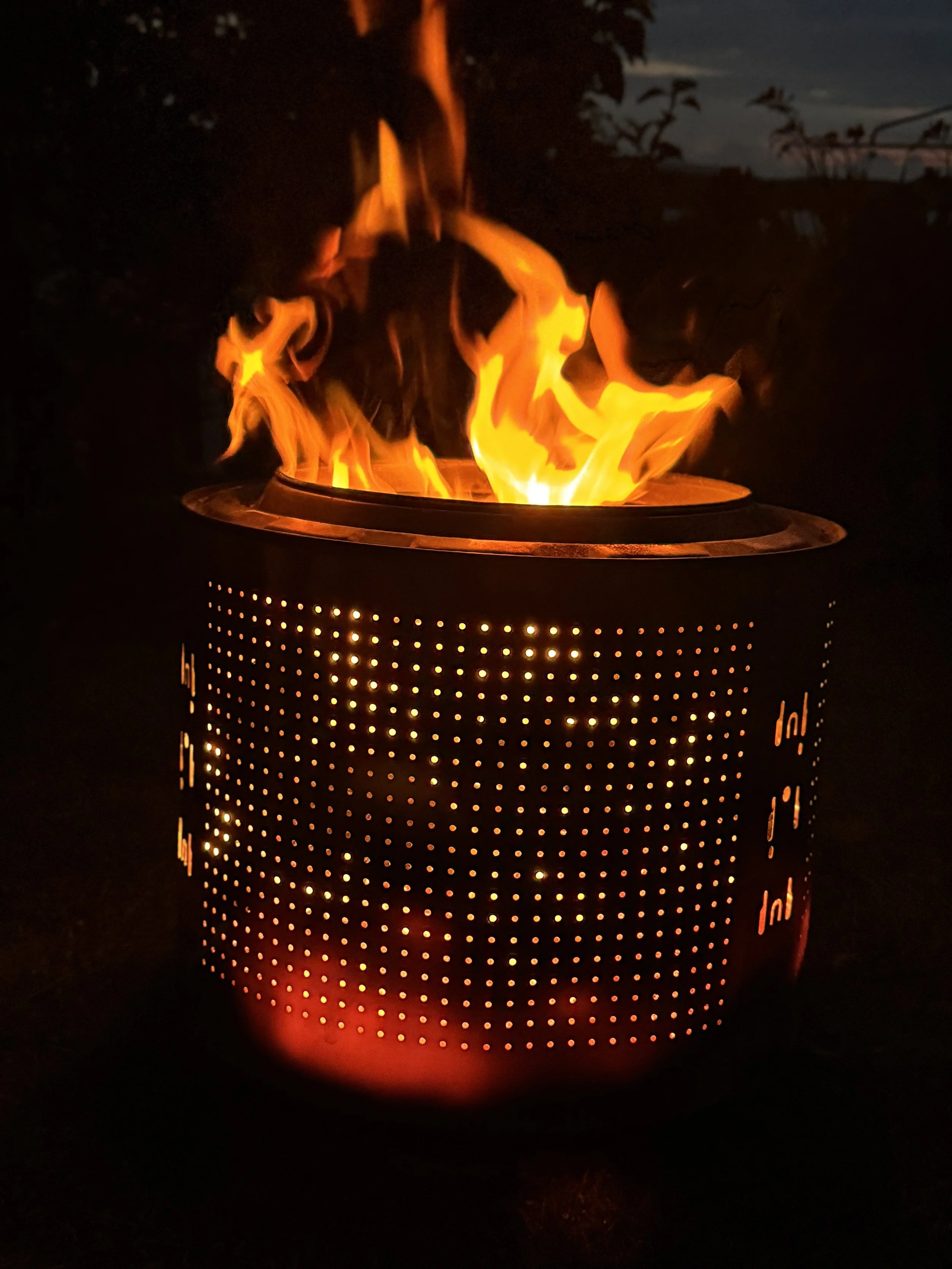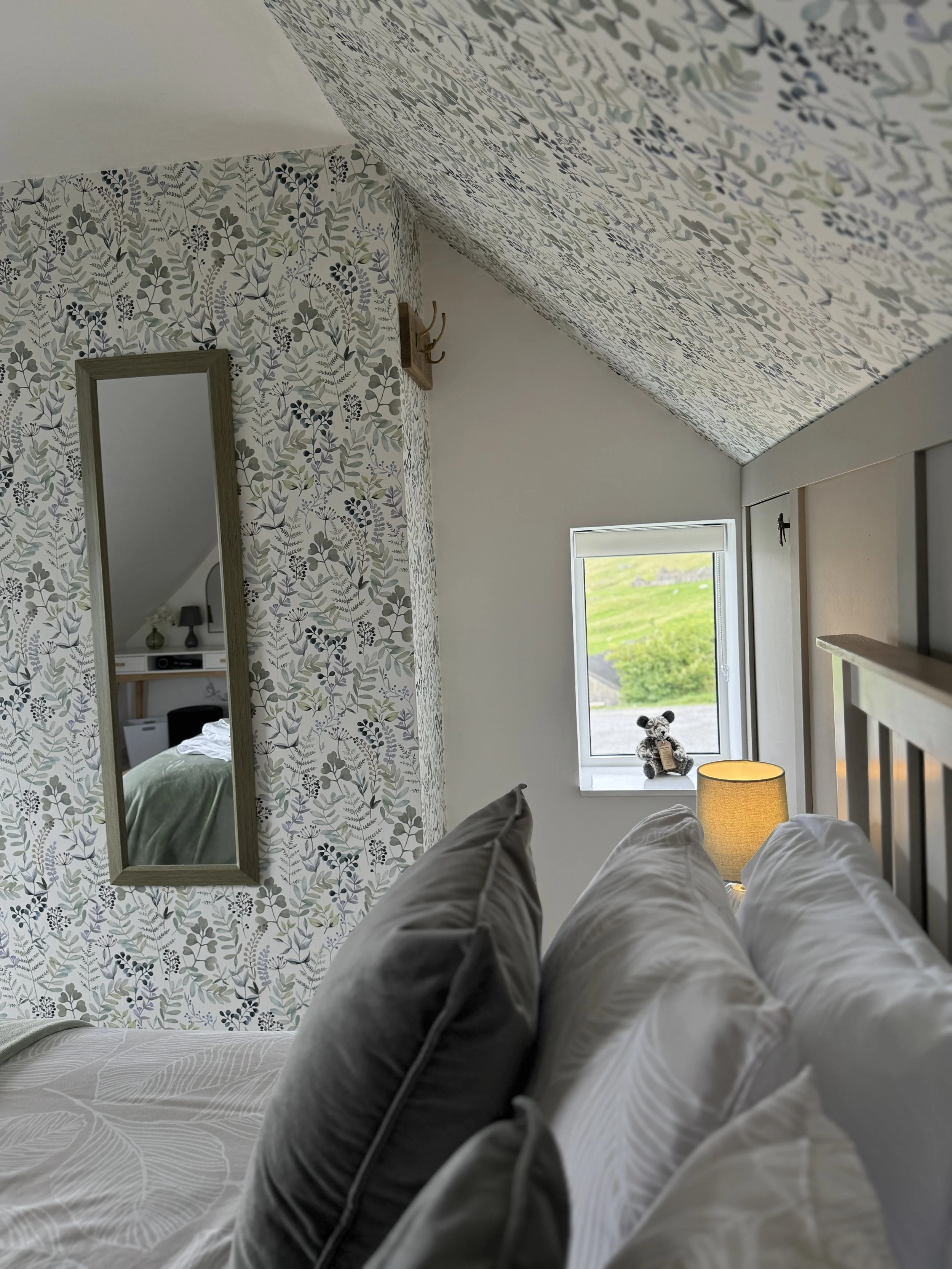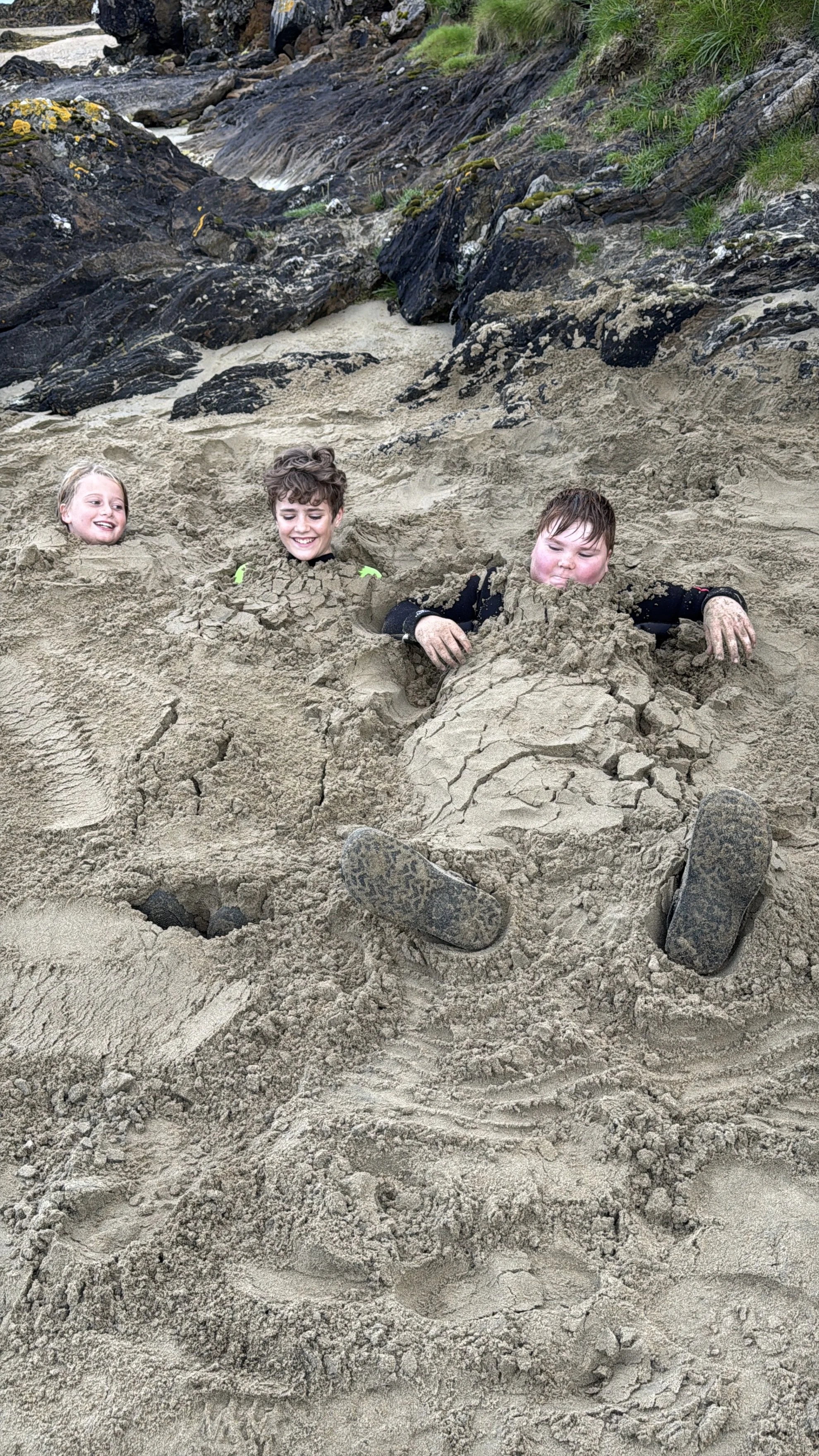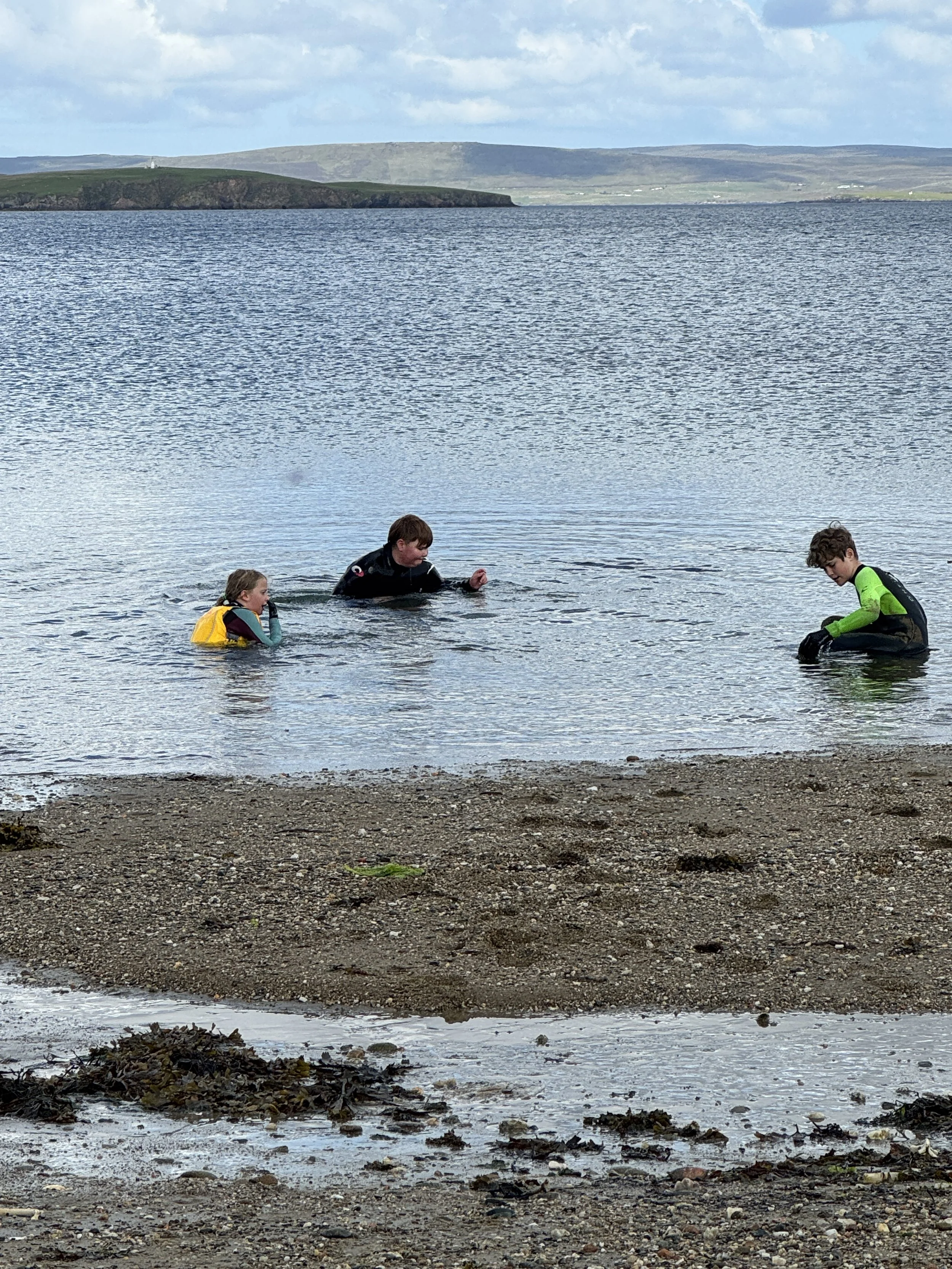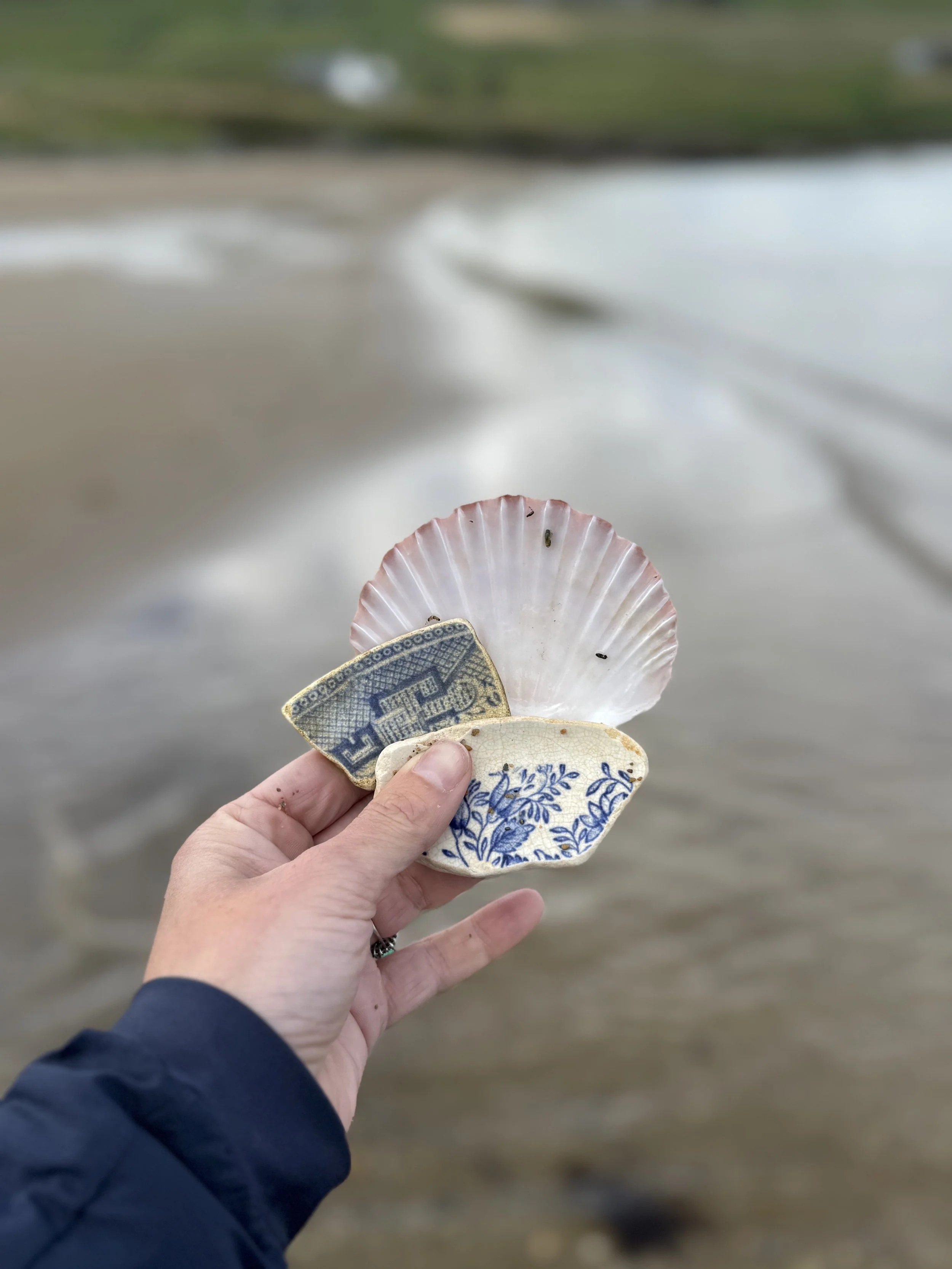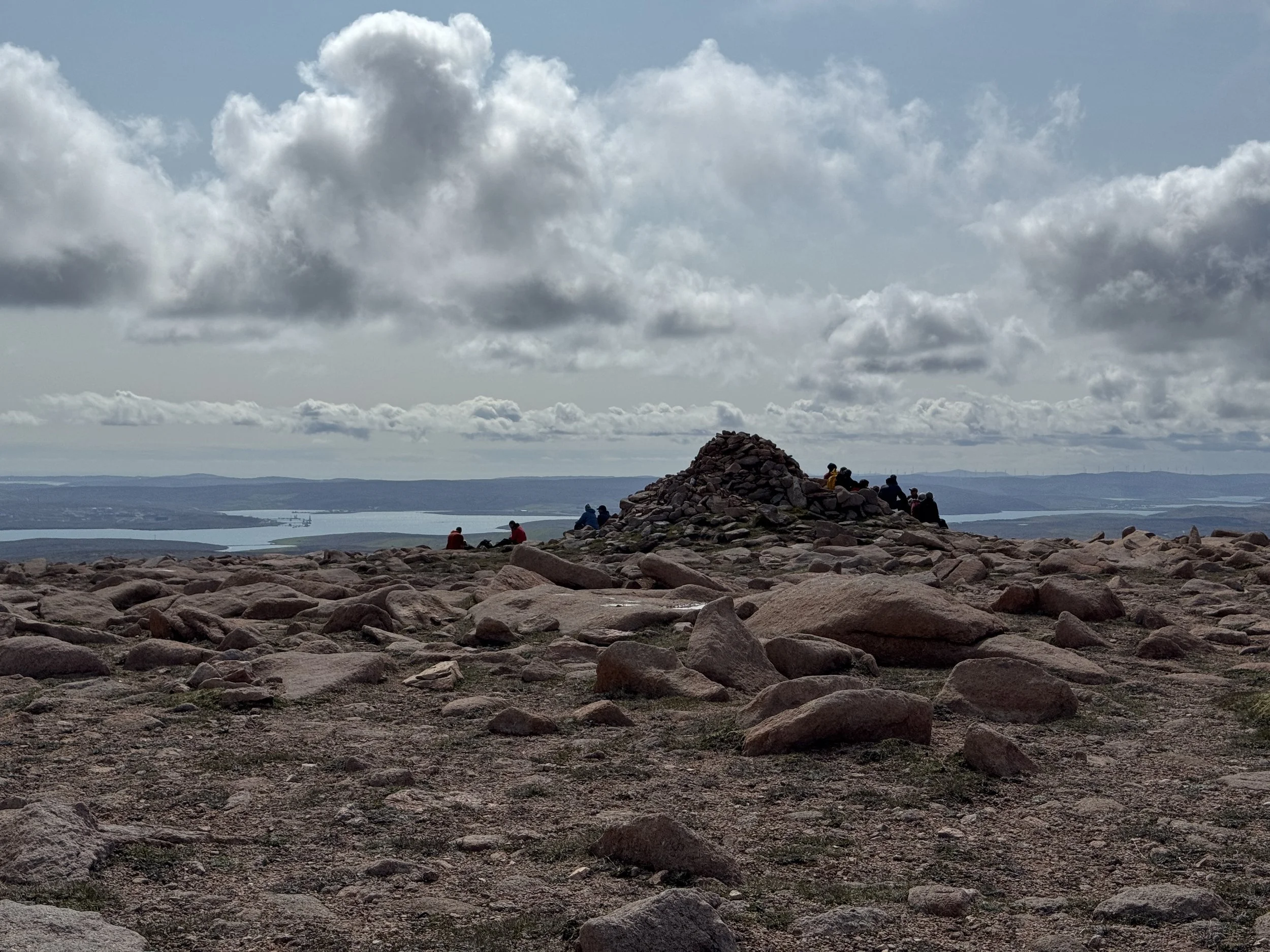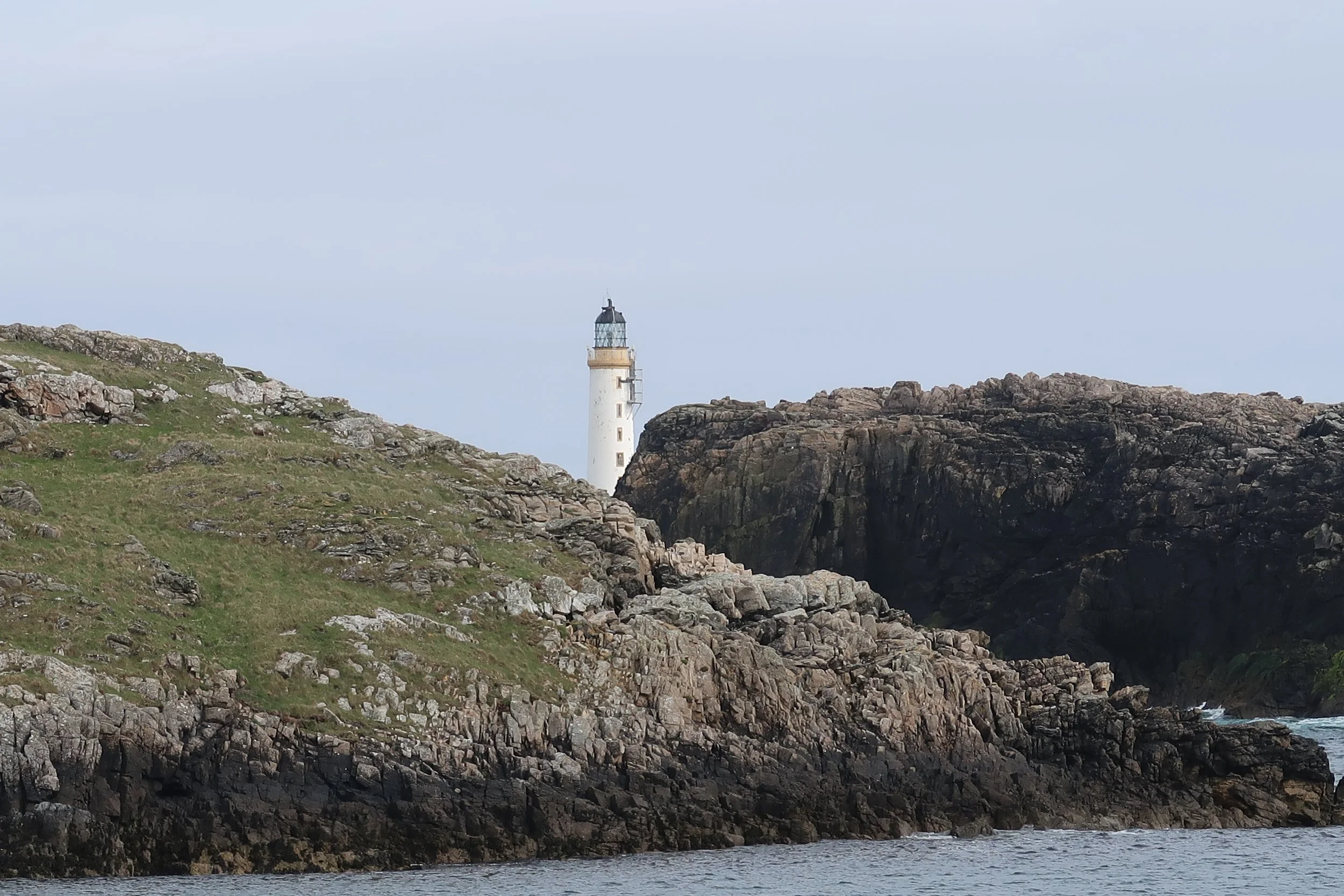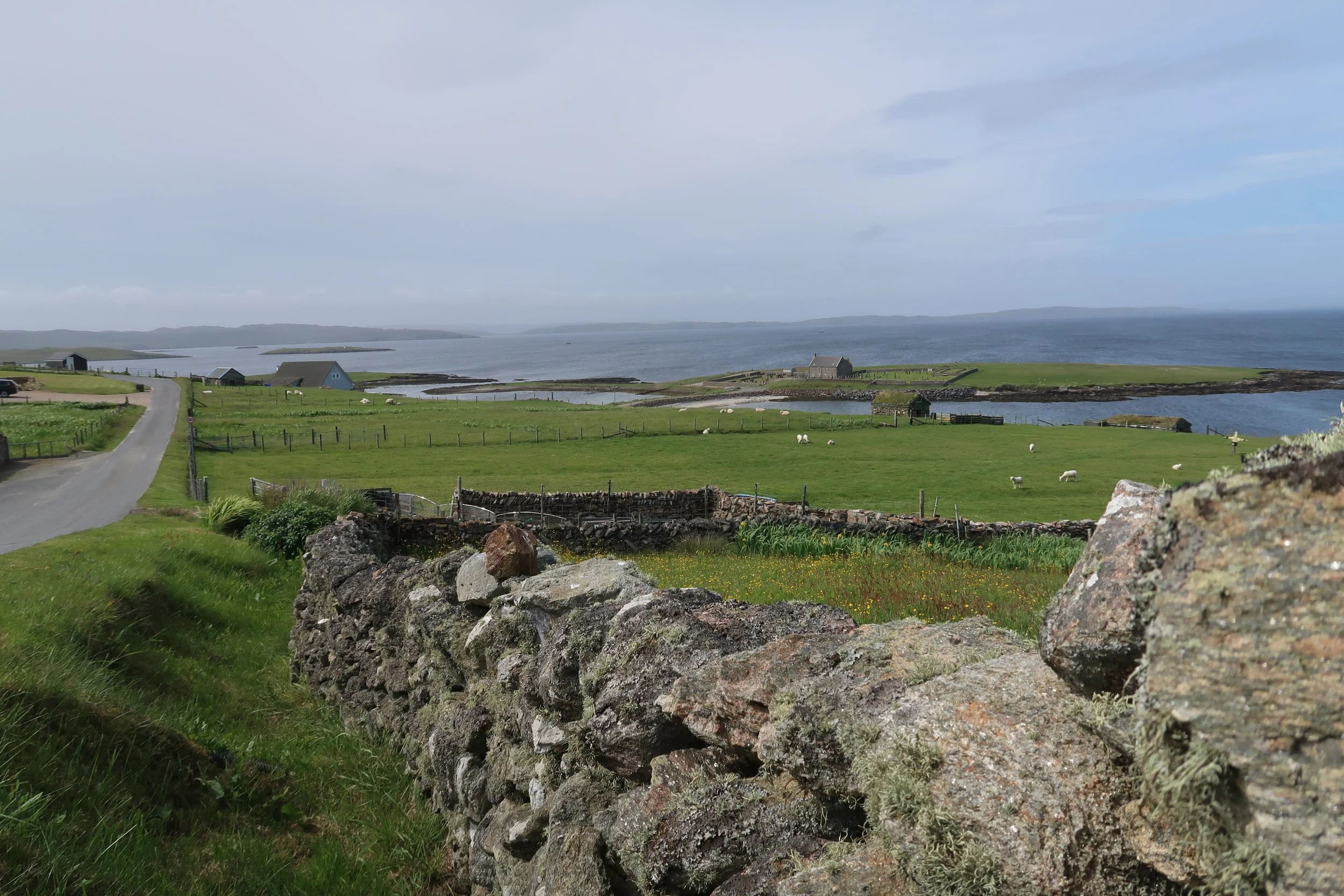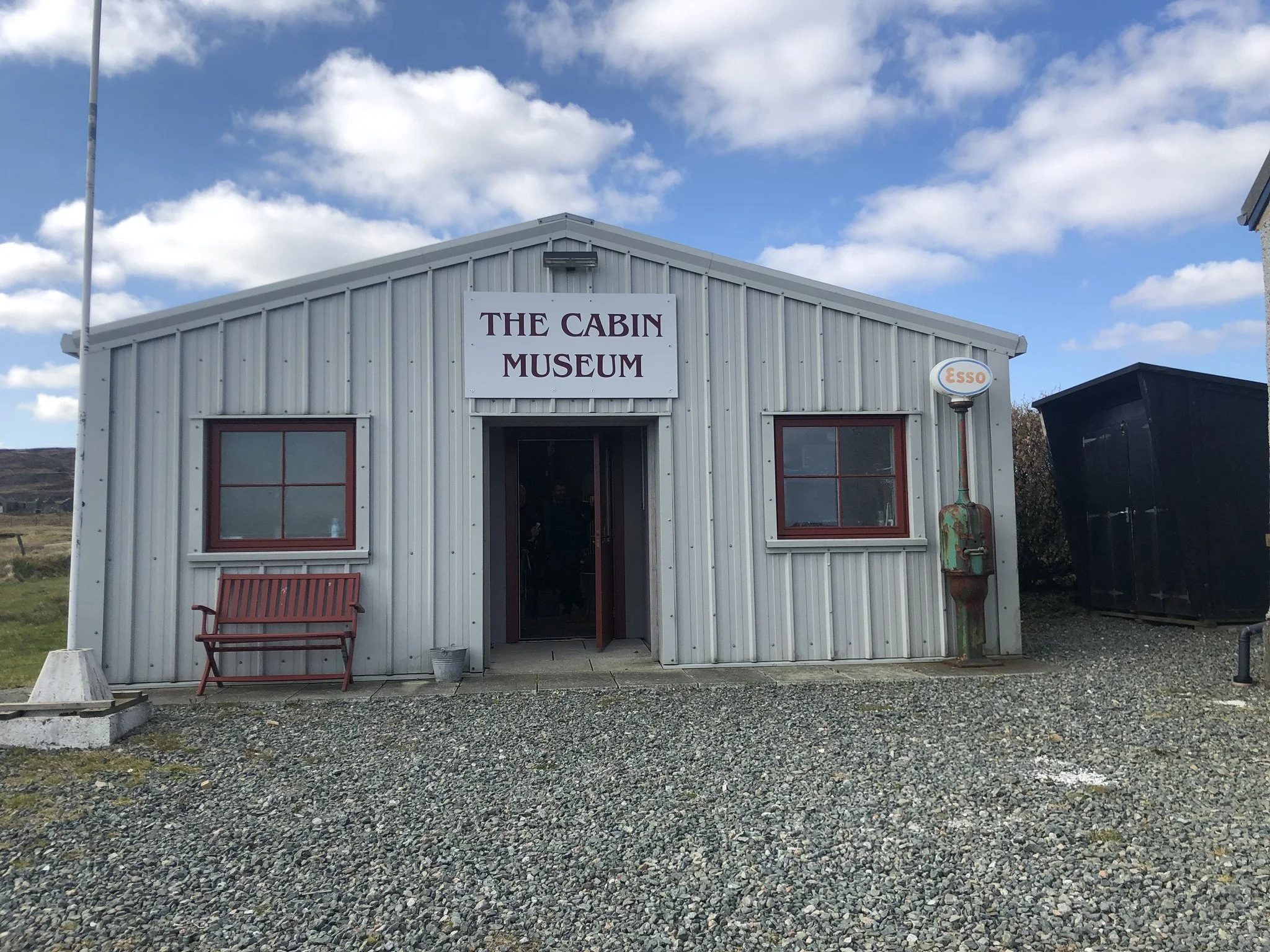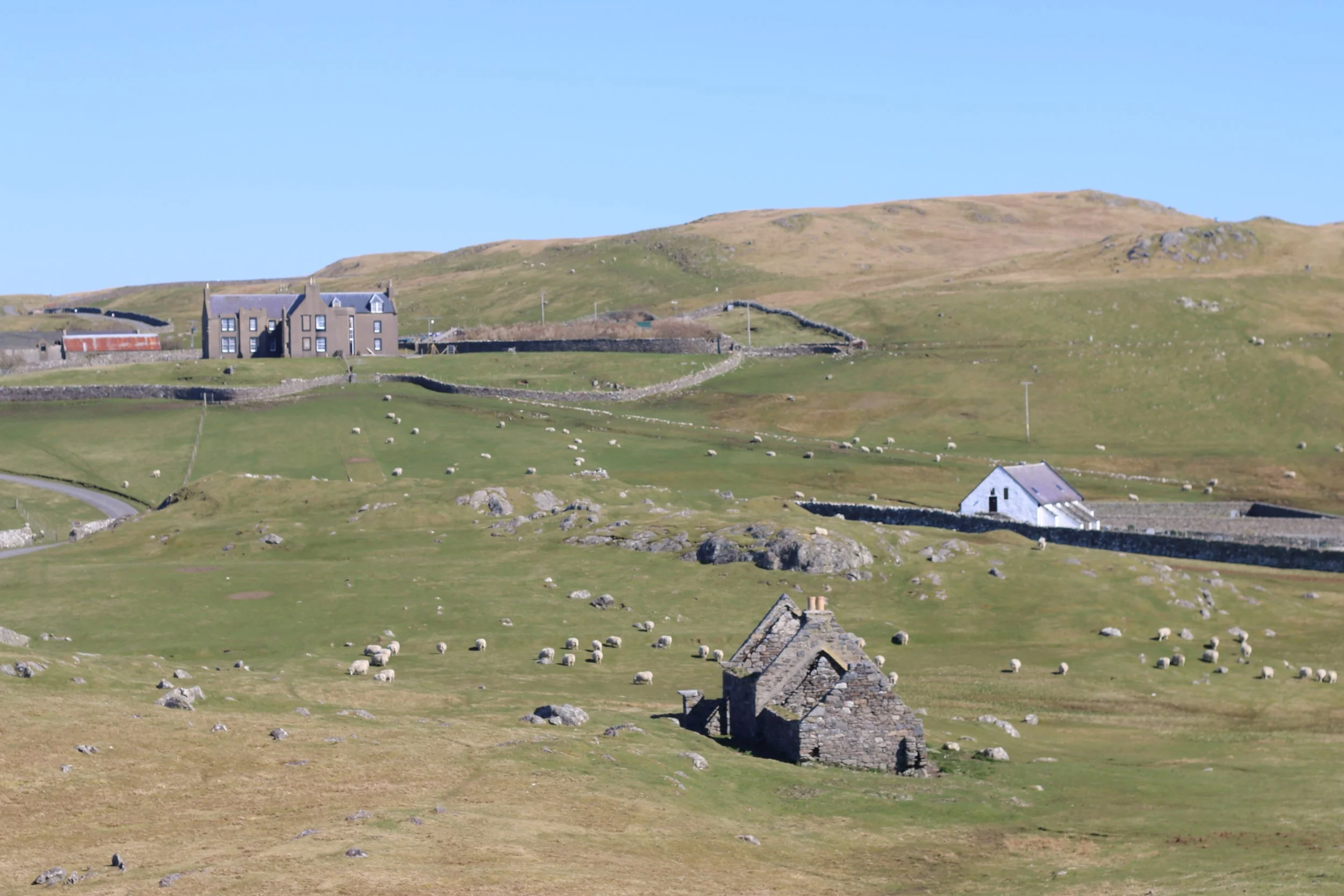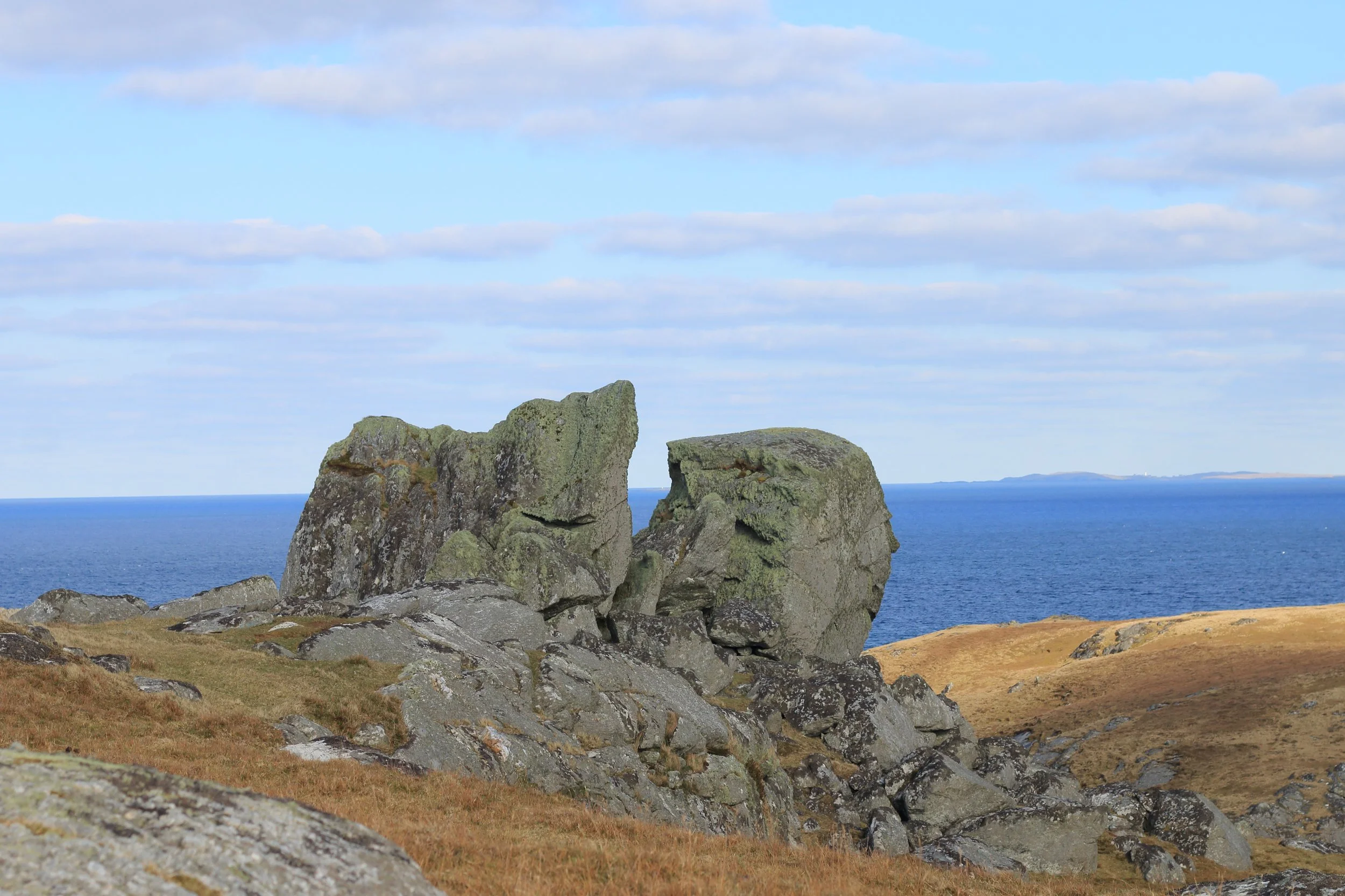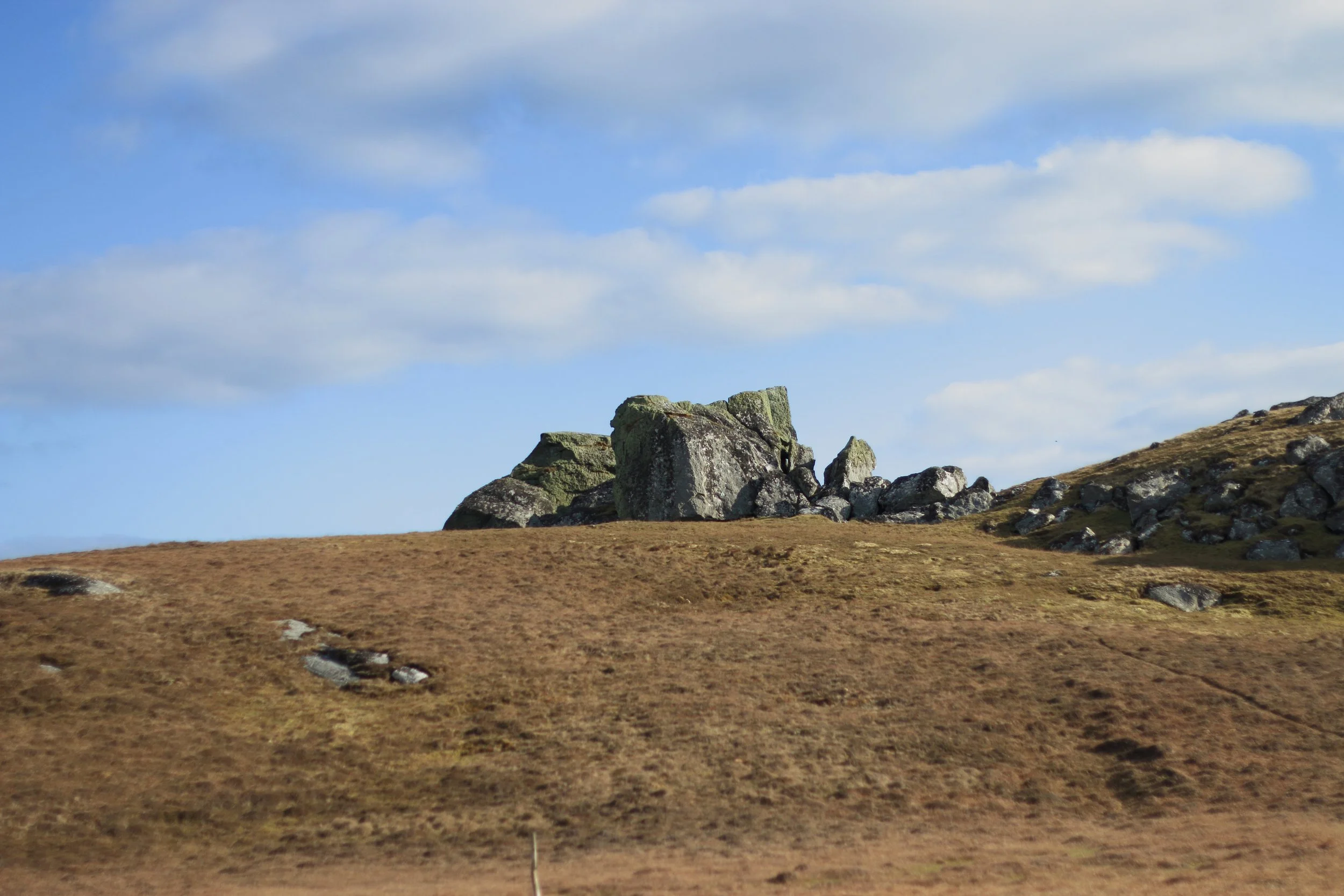Kirkabister self-catering: a review and itinerary for your stay
“A place to spend a golden afternoon
To search, like children, for a pretty stone,
An ornament, an aid to memory;
And then to feel that we are not alone,
That there are others with us on this beach.”
In memory of Gibby who loved Vidlin dearly.
Kirkabister sits at the end of a winding country road, just outside Vidlin. The road, lined with houses both old and new, is interspersed with flowering “Shetland” roses, their unruly, bright blooms spilling over stone walls, and stunted sycamores bent against the wind and decades of weather. Meanwhile, the cherry-red fuchsia adds a splash of colour to the verges. The road weaves its way along the eastern side of the sheltered Vidlin Voe, where the house we were staying for the weekend sits tucked into the fold of the hill. Its name – Kirkabister – suggests that it’s a place that has long been inhabited, and the fertile, green slopes that fall towards the sea show traces of the past, as well as the people who lived and worked there, etched into its gentle contours.
New to the self-catering market this year, Kirkabister offers more than just a place to stay — it’s a home that’s been lovingly brought to life. Owner Lynsey has poured care and attention into every detail, ensuring the house reflects both its heritage and the comforts of modern living.
The traditional whitewashed cottage — a classic two-up, two-down design — has been thoughtfully renovated. While its original character remains intact, there’s a quiet elegance in how old and new sit side by side. From the moment you step inside, it’s clear this is a space shaped with intention: warm, welcoming, and full of charm.
The kitchen is sleek and modern, yet full of character — a space made for gathering. A large window looks out over Vidlin Voe, perfectly framing the ever-changing sea. From here, you can watch the Filla, the Skerries inter-island ferry, as it makes its regular crossings between Vidlin and the outlying isles — but more on that later.
Inside, the details tell a story. Renovated church pews offer a unique and welcoming place to sit, and treasures found within the fabric of the walls whisper stories of those who once lived here, while carefully chosen ornaments and thoughtful touches create a warm, social atmosphere. It’s the kind of kitchen that invites slow mornings, shared meals, and long evenings with friends, good food, and a glass of wine (or two).
Moving through the house, the lounge is stylishly decorated with a log burning fire – perfect for cosy evenings after a day in the hills exploring the surrounding landscape. On the ground floor, a double bedroom enjoys the same sea views across the enclosed patio area – a peaceful spot that catches the golden evening sun, ideal for a quiet drink or simply soaking in the stillness.
Upstairs, three further bedrooms provide space for up to six guests, making Kirkabister ideal for families or groups. The master bedroom is particularly special, with three windows that open up the views in every direction: to the front, the ever-changing sea, and from the gable end, a perfectly framed glimpse of the ruined house of North-Hill — a silent, weathered reminder that this quiet corner of Shetland has provided life and laughter for generations.
Just off the master bedroom, a bright and peaceful study looks straight out to sea — an inspiring spot for a longer 'working' holiday or a quiet creative retreat. With two ergonomic chairs and an abundance of natural light, it’s a comfortable, airy space designed for focus... or for gazing out the window and letting your mind wander. Whether you're writing, sketching, Zooming, or simply daydreaming, this little corner invites both productivity and pause.
Tucked into the eaves is one of the house’s most delightful surprises: a cabin-style bed that’s been cleverly built to create a snug, self-contained sleeping space. Partitioned from the rest of the room, it offers privacy and a playful sense of adventure — the perfect den for bairns (young or fully grown). It’s a space that sparks imagination, ideal for bedtime stories or peaceful hideaways.
Across the hall, a bright and spacious twin room completes the roll-call of sleeping spaces. Like the rest of the house, it’s filled with natural light and a sense of calm, offering flexibility for families, friends, or anyone who values a bit of extra room.
In total, Kirkabister comfortably sleeps eight guests, making it perfect for group getaways or multi-generational family stays. With two well-appointed bathrooms, there’s no need to queue for the shower — just one more thoughtful touch that makes life here easy, relaxed, and ready to enjoy from the moment you arrive.
What we got up to, and what you can enjoy too - an itinerary for your stay
We arrived on a Friday evening, just as the low sun was pouring through the kitchen window, casting soft, dancing shadows across the ceiling — reflections from the sea beyond.
After a relaxed dinner — accompanied by a bottle of wine thoughtfully left by Lynsey — we laced up our boots and headed out. A track leads straight from the back of the house up into the hills, and we couldn’t resist seeing where it might take us.
Looking down the hill towards Kirkabister
The boys came prepared — trout rods in hand and a list of lochs already marked out. Just behind the house, nestled into the hills, they’d scoped out Starns Water, Dallican Water, and Longa Water — all within easy reach of Kirkabister.
Shetland is a fantastic place for freshwater fishing, with hundreds of lochs dotted across the islands. The Shetland Anglers Association makes it easy to get started, offering a simple permit system that covers the entire season. At just £30, the permit allows both locals and visitors to fish freely across all association waters. Even better, junior anglers under 16 fish for free — a brilliant way to get younger ones involved without any extra cost.
Permits can be bought here – http://www.shetlandtrout.co.uk/permits.html
The lochs aren’t just for fishing — they’re also brilliant for wildlife watching. One of the real highlights was spotting a red-throated diver on Starns Water. Known locally as rain geese, these beautiful and elegant birds are a special sight — sleek, graceful, and often heard before they’re seen, with their haunting, far-reaching calls.
They nest beside freshwater lochs like these, and are easily spooked, so it’s important to keep a respectful distance and avoid disturbing their nesting grounds. Watching them glide across the water, undisturbed in their quiet world, under the golden glow of sunset, was a real privilege — one of those Shetland moments that stays with you long after the sun has set.
Unfortunately for the boys, it wasn’t just the rain geese putting on a show that evening — the midges were out in full force too. Those tiny, determined biters who ruin many a simmer night drove them back toward the comforts of Kirkabister, fishing dreams temporarily dashed, and itchy welts forming.
We pressed on, following the track up to the summit of the 120-metre hill behind the house. The climb was strewn with boulders left over from the last Ice Age, and boggy mires made it tricky underfoot, but the reward at the top was more than worth the effort: below us lay Lunning, a quiet crofting settlement folded into the coastline, while across the water, Whalsay shimmered in the soft evening light.
The sea stretched endlessly in every direction, and standing there, in silence, save the laverock (skylark) and whaaps (curlew), all around — it felt like we were standing on top of the world. The ridgelines of neighbouring headlands and hills unfurled in layers of deepening dark, fading into the distance under a sky ablaze with the setting sun. All around us, bog cotton nodded and danced a merry jig in the breeze, with snowy white tops catching the light.
From the summit, we followed the track down to Lunning, rejoining the quiet single-track road that winds back toward Kirkabister. We completed the three-mile loop just as the last colours of the sunset slipped into twilight, and a cool stillness settled over the land, with dew gathering on the heather, as the air took on that unmistakable scent of evening.
Day two – rooted to Lunnasting
We woke to the promise of a bright day — sunshine spilling through the windows and a fresh breeze in the air. It was the perfect kind of Shetland morning: crisp and clear, with just enough warmth to make for a pleasant walk, but not so much that the hills felt like hard work. Ideal conditions for stretching our legs and seeing where the day might take us.
After breakfast, we set off with a picnic packed, parking at the end of the Lunning road, just a mile or so from Kirkabister. Leaving the Landrover here, we headed off with the OS map (I have mine downloaded on my phone) south along the coast from Lunning towards Bonidale.
Shetland has so many coastal walks, and my favourite thing to do, is pour over the contours of the OS map, looking for coastal features – stacks, geos and inlets – abandoned crofting townships, and archaeological remains. Some of the very best walks are right on your doorstep — no need to go far. And that’s one of the real joys of exploring from a base like Kirkabister: you can set out on foot and, within minutes, feel like you’re in another world. The coastline here is so rich, so expansive, that you’re unlikely to see another soul. Just the wind, the sea, and the quiet footprints you leave behind.
Want more from Shetland? Pick up a copy of my Guidebook today.
Discover hidden gems and rich history with our guidebook. Navigate like a local to find the best scenic spots, and cultural highlights. Our maps, itineraries, recommendations, and tips ensure you make the most of your time, whether you're a first-time visitor or returning. Purchase our guidebook today for a memorable journey. Your perfect trip starts here.
The walk itself was relatively challenging in places — weaving across soft boggy ground and navigating a few steeper gradients — but always with the sea at our side. We kept one eye on the water, hoping to spot otters or the occasional seal, both common along this stretch of coast.
High above, gannets were hard at work, diving like white torpedoes into the sea, their sleek bodies slicing through the surface and leaving bright trails of spray behind them. Out in Lunning Sound, a few mackerel boats were hauling in the day's catch — silvery fish dancing on the lines, destined for Monday’s market. It felt like we were walking through a living postcard.
Bonidale is a place I’ve been before — way back in 2009, in what feels like a different lifetime. It was before smartphones, before children, and when my most loyal travelling companion was a Sony Cybershot camera, tucked into my jacket pocket.
I was fresh out of university, wearing borrowed hiking boots, and with absolutely no idea where life would take me. Standing there again, all these years later, with shoes that are my own, and different stories, was quietly moving — a reminder of how some places stay the same even as we change around them.
Bonidale itself had changed. The house is now slowly crumbling back into the earth, its stonework weathered, its windows long since gone, and rafters block the passage inside. The last time I was here, it was raining hard. We arrived soaked to the skin, shivering and grateful to find shelter.
Back then, the house still had a roof, of sorts. We gingerly stepped inside, lit a small fire in the hearth, and hung our dripping coats and boots to dry. At the time, it felt like we were intruding — stepping into a life and a place that didn’t belong to us. There was a sense of reverence, of walking softly through someone else’s story.
But now, looking back, I see the beauty in that moment for what it was: a quiet exchange between past and present. I couldn’t help but wonder if that small fire we lit all those years ago was the last to grace that hearth — the final flicker of comfort in a home that once echoed with generations of voices, footsteps, and stories.
When we arrived back at Kirkabister, a message from Lynsey was waiting. Her grandad, Gibby, had passed away, aged 94 — a long life, well lived. It was a quiet jolt, a reminder of how precious and fleeting life is, and how deeply rooted we can be to place, to people, and to memory.
Despite feeling like intruders on a community’s grief, in a way, it felt fitting to stand in this landscape, shaped by generations, and think about those who came before and the stories they’ve left behind. A gentle reminder to pause, to notice, to hold the moment, however fleeting it may be.
When we arrived at Kirkabister, I’d already spotted the fire pit tucked away in the shed—ready to go, with kindling chopped and logs perfectly dried. So, we made a quick stop at the Vidlin shop, a surprisingly well-stocked local grocery store, offering everything from fresh fish and butcher’s cuts to tent pegs—and, crucially for us, marshmallows and skewers.
After a hearty meal of chilli and nachos, washed down with a mellow Malbec, we coaxed the fire to life and settled outside. As the flames flickered, we toasted marshmallows well into the small hours, the western sky deepening to an inky blue overhead. It was a quiet reminder that the nights of the Simmer Dim—those long, light Shetland summer evenings—are now behind us, and the darkness is slowly creeping back.
Slow Sundays and sea swimming
I always have the best of intentions to get up and get going on a Sunday… but now that there’s a teenager in the family, mornings have taken on a new rhythm. Easier than the toddler years, certainly — but slower. Kirkabister is the perfect place to embrace a lazy start, particularly with lazy teens in tow, and for me, that means a steaming mug of tea (I’m not a coffee drinker), brewed for longer than it probably should be.
I took my tea back to bed, wrapped in the sumptuous duvet and peace of the morning, and watched through the window as salmon boats passed quietly back and forth across the voe, heading to and from the nearby fish farms. Shetland is renowned for its aquaculture, particularly salmon and mussels, and Vidlin has always played a leading role in the industry. If you’ve ever eaten farmed salmon in the UK, there’s a one in three chance it came from here — maybe even from Vidlin. And perhaps more surprisingly, over 80% of the UK’s mussels are grown and harvested in Shetland’s clean, tidal waters.
It was one of those slow, thoughtful mornings — no rush, just the sea, the light, and the quiet movement of boats.
Eventually, and with the morning ticking away into early afternoon, we packed our rucksacks, threw the wetsuits in the back of the Landrover and made our way to Ollaberry for some beach treasure hunting and sea swimming.
Afterwards, we made the essential stop at Frankie’s Fish & Chips in Brae — a Shetland institution, beloved by locals and visitors alike. Crisp batter, proper chips, and the freshest fish you could ask for, all caught by local boats.
With the sun beginning its slow descent once more, we headed back to Kirkabister to soak in the peace of our final night — enjoying the stillness and quiet fatigue that only comes at the end of a good day, in a place that already feels like home.
On Monday morning, we packed up our things, stuffed the salt-crusted wetsuits into the boot, and set off — back to real life, back to the week ahead. I felt refreshed and recharged, but with that familiar ache that comes from leaving the country and heading back to town.
With one last look across the hills, purple-washed with flowering heather, I turned back onto the A970, heading south to town.
I’m a home body — that’s what we’d say here in Shetland about folk who like to stay close to their roots. I grew up in the countryside, amongst the rolling hills, and I’ve always felt most at ease in places that carry a sense of belonging, where the land feels lived in and the walls of tumbledown crofts hold stories that span the ages.
The moment I stepped through the door at Kirkabister, I felt it — that quiet sense of home. A place of peace, comfort, and connection. Somewhere to exhale.
If you're looking for a place to slow down, breathe deep, and feel truly at home — whether for a quiet weekend or a longer escape — Kirkabister is waiting, and you’ll be oh so glad you came.
To check availability or make a booking, please email kirkabister24@gmail.com or visit their online booking system to start planning your stay in this beautiful corner of Shetland.
Some other ideas for the area
This quiet corner of Shetland, with its strong sense of community and place, is somewhere you could easily stay rooted for your entire visit — content to wander the hills, watch the tides, and soak in the peace of it all. But it also makes a brilliant base for exploring further afield.
From Kirkabister, you're just thirty minutes from Lerwick, with its museums, shops, and harbour-town buzz — and equally, thirty minutes from the dramatic cliffs of Eshaness in the north, where the Atlantic meets the rock of an ancient volcano, and the landscape tells stories that lead you through a geological journey spanning millions of years.
We only scratched the surface during our stay, but there’s so much more to explore in the area. If you’re planning a longer visit to Kirkabister or the Vidlin area, here are a few suggestions to help you make the most of your time:
Hike up Ronas Hill
You could hike Ronas Hill and on to the Lang Ayre – this day-long walk across 9 miles (14.5km) of tough terrain, climbing Shetland’s highest hill, and taking in the mile-long stretch of Da Lang Ayre will leave a lasting impression, but is not for the weary walker.
Spend a day in the Skerries
Out Skerries, known locally as Da Skerries or just Skerries, are a small, low-lying trio of islands – Bruray, Housay and Grunay – 13 miles (21km) off Shetland’s east coast and 4 miles (6.5km) northeast of Whalsay. Their coastline is a patchwork of small rocks and skerries that rise from the sea on Shetland’s eastern horizon. The ferry (I mentioned earlier), Filla, leaves from Vidlin, and I wrote a helpful blog about a day trip.
Take a trip to Whalsay
Similarly, the ferry to Whalsay leaves from Laxo (just before you reach Vidlin), and offers visitors a fantastic day trip. Whalsay, meaning “whale island” in Old Norse, and endearingly referred to as the “Boanny Isle” by locals, is an island off Shetland’s east coast with a small, tight-knit island community of about 1,000 people. It’s one of Shetland’s smaller inhabited islands and its economy and heritage are deeply rooted in fishing, still enjoying relative prosperity brought in by the nets of the local fishing fleet.
Root yourself in wartime history
In Wirlie, just after Laxo, stop off at The Cabin Museum, which specialises in military paraphernalia. This wartime museum displays a unique collection of artefacts and photos detailing Shetland’s contribution to the two world wars. Generally open May to September (Tues, Thurs, Sat & Sun 1-5), but check their Facebook page for up to date details: The Cabin Museum.
Lunna is home to Lunna House, and played a key role in the Shetland Bus Operation, a covert Second World War operation that used Norwegian fishing boats to ferry refugees, agents and weapons back and forth across the North Sea. The striking Lunna Kirk (St Margaret’s) was, until recently, the oldest working church in Shetland, and it’s believed that parts of this historic church date back to the 1100s – look out for its unusual structure, thick buttresses and lepers’ squint (allowing people with leprosy to see and hear the service without entering the congregation). The grounds hold the graves of several Norwegian sailors lost in the war. The kirk has been bought by the community, who hope to bring it back to life, using it as both a place of worship and an exhibition space for displaying local history.
Walk to the Stanes of Stofast
Beyond Vidlin, Lunna Ness is well worth a visit: this beautiful peninsula projects from the Mainland towards Yell and Fetlar and is a great place to walk the coastline and look for otters. The Stones (sometimes “Steens” or “Stanes”) of Stofast (HU 50892 71598), can be seen on a fantastic 2-mile (3km) walk across open moorland towards this series of impressive boulders that straddle the ridge of the hill. Folklore tells us that these were left by the giants – however, it’s more likely that these are glacial deposits laid down during the last Ice Age.
I hope you enjoyed reading this, and consider Kirkabister as your base for your next Shetland adventure,
With love,
Ways you can support my work…






